

EMI Cassette Tapes
Original Album Series
#04. Rubber Soul (TC-PCS 3075)
(Update: 26th. January 2025)




| New Records from EMI (September 1970) |
||||
| SHEET: FRONT | Musiccassette Pages |
EMI
Original Promotional dealer leaflet. This promotional leaflet would detail the forthcoming September 1970 Records, Musicassettes, Reel to Reel, and 8-track cartridges releases. It says that cassette tapes and 8-tracks of "Rubber Soul", "Revolver", and "A Collection Of Beatles' Oldies" will be released at the same time on this September. |
||
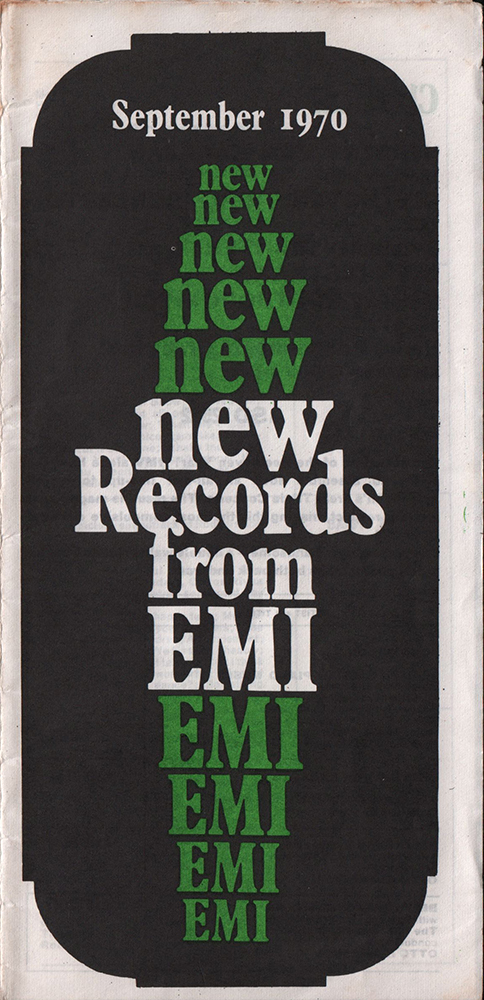 |
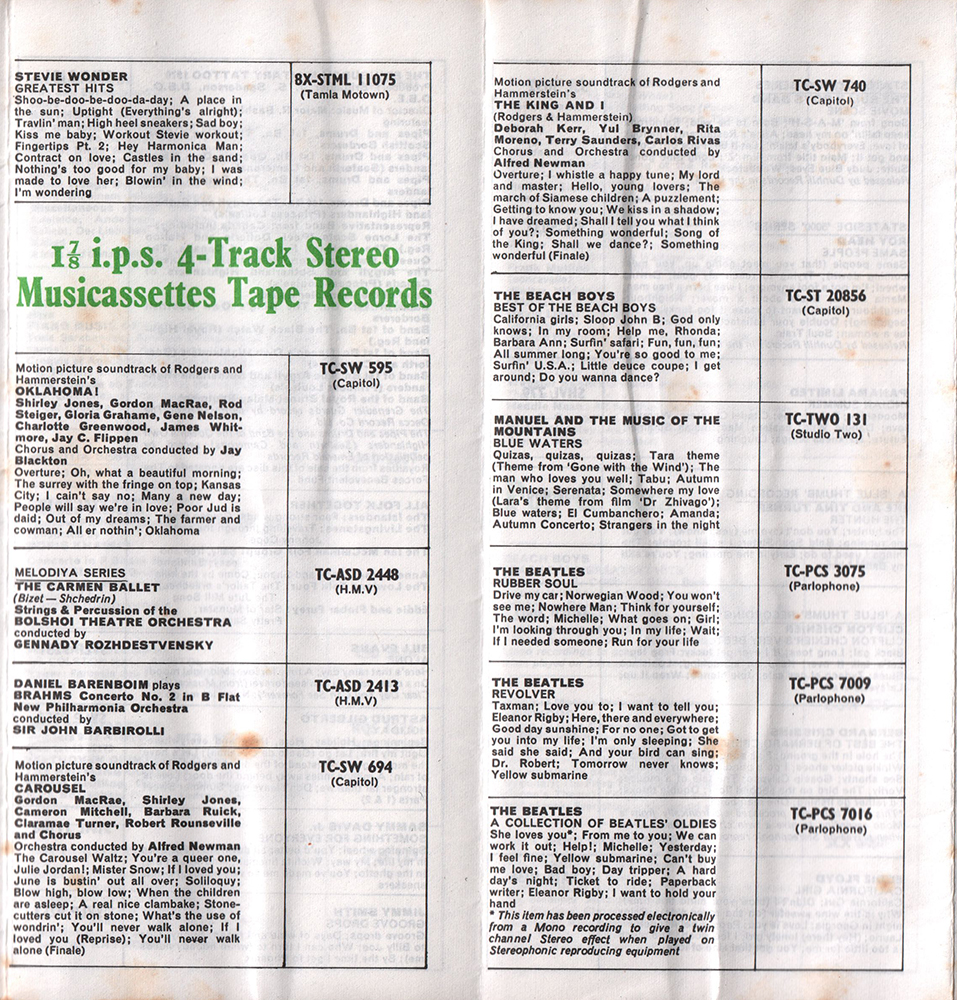 |
|||
| SHEET: BACK |
8-Track Information:
CLOSE UP |
Cassette Tape
Information: CLOSE UP |
||
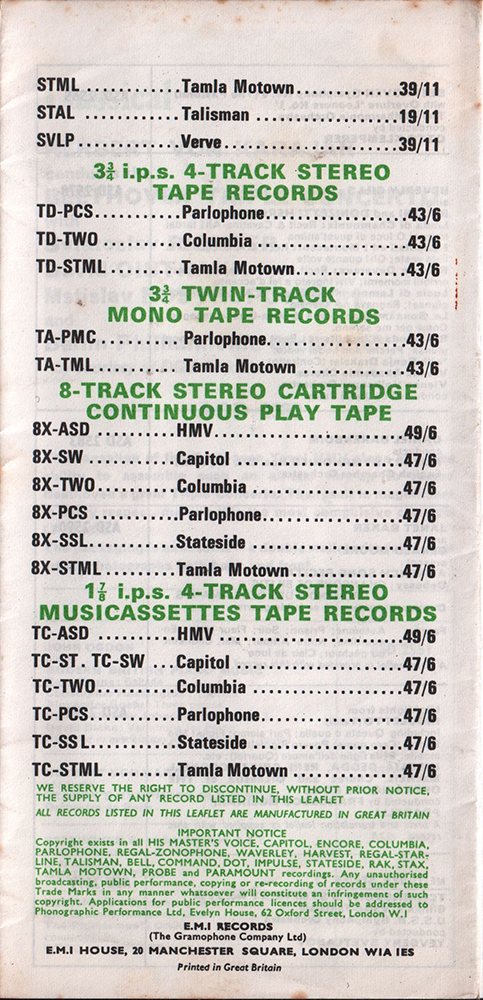 |
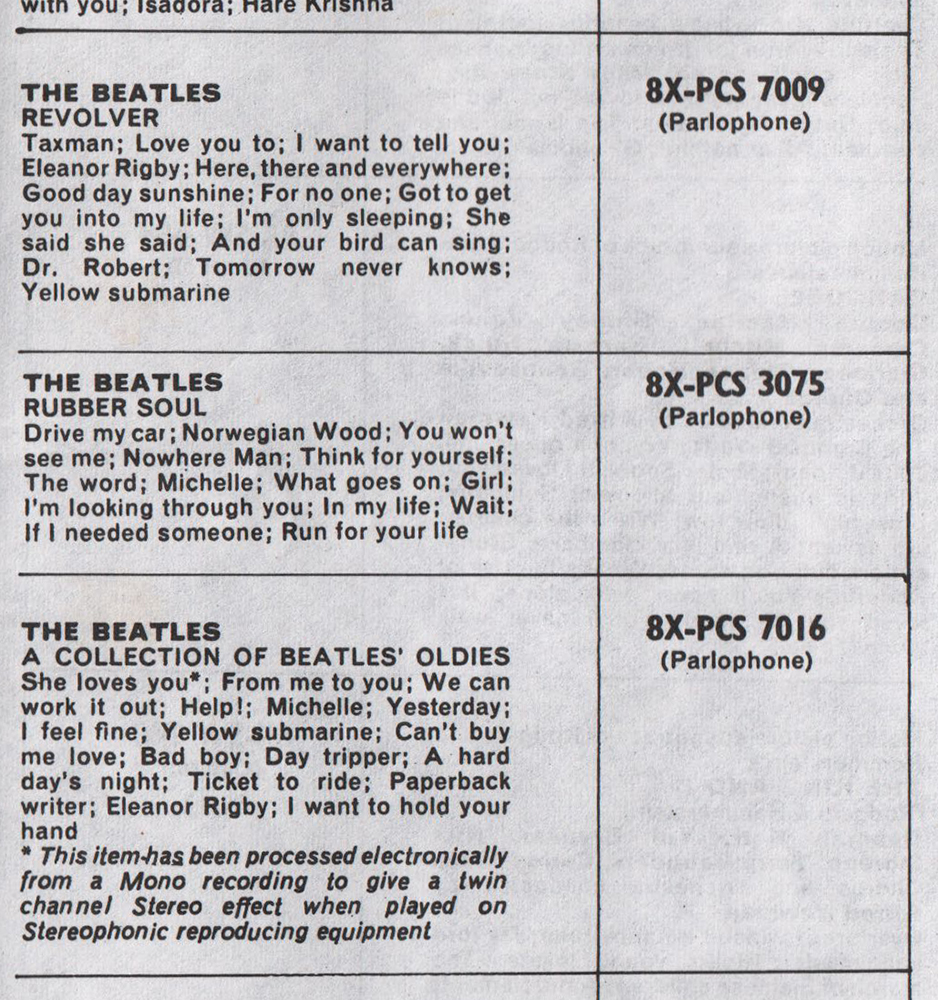 |
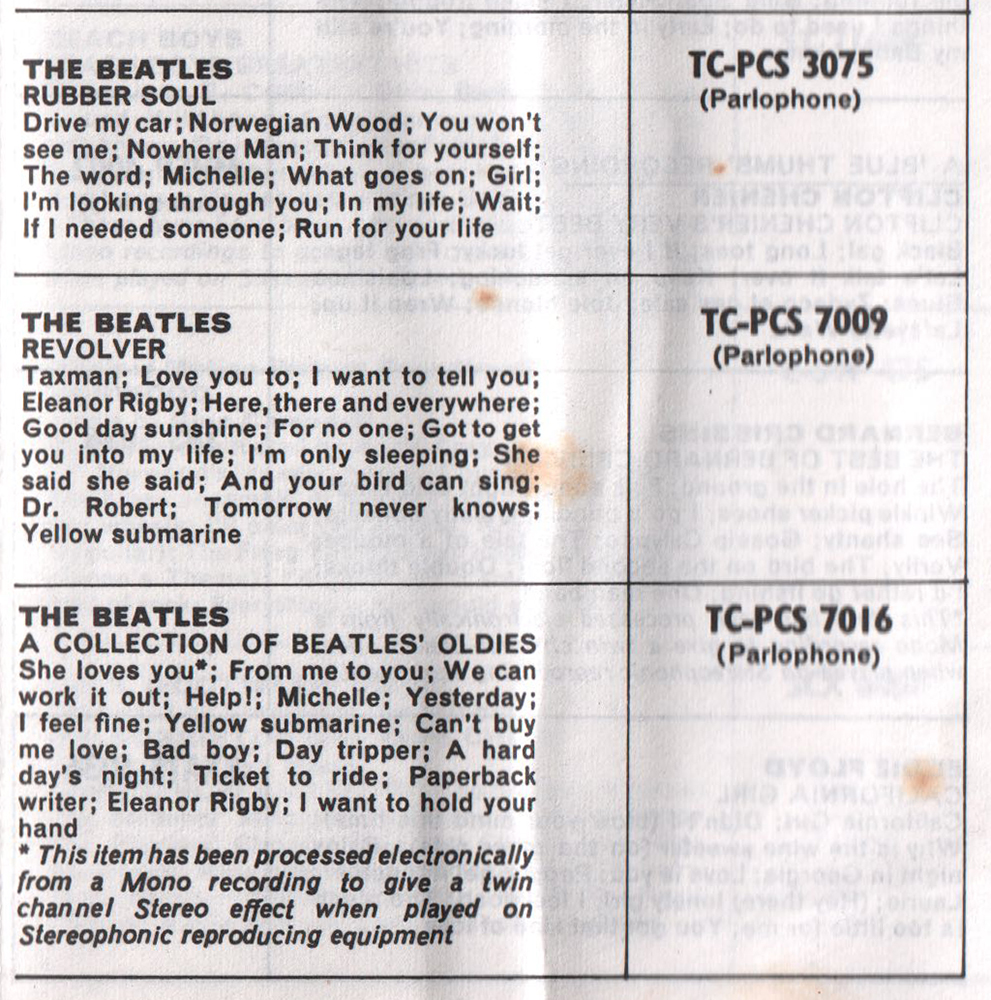 |
||
|
TITLE
|
RUBBER SOUL |
|||
| CATALOG NUMBER | TC-PCS 3075 / 1E 262 o 04115 |
|||
|
RELEASE DATE
|
September 1970 / First Issue | |||
| TRACK LISTING | SIDE 1 | SIDE 2 | ||
| Norwegian Wood (This Bird Has
Flown) [A2] |
Drive My Car [A1] |
|||
| You Won't See Me [A3] | If I Needed Someone [B6] | |||
| Think For Yourself [A5] | What Goes On [B1] | |||
| I'm Looking Through You [B3] | Girl [B2] | |||
| Nowhere Man [A4] | In My Life [B4] | |||
| Michelle
[A7] |
The Word [A6] | |||
| Wait [B5] | Run For Your Life [B7] | |||
| CASSETTE CASE AND TAPE |
CASE FRONT | CASE BACK | SIDE 1 --> Click! | SIDE 2 --> Click! |
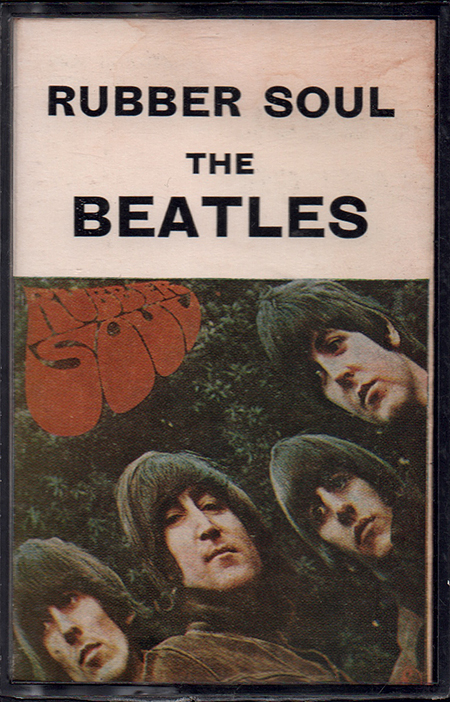 |
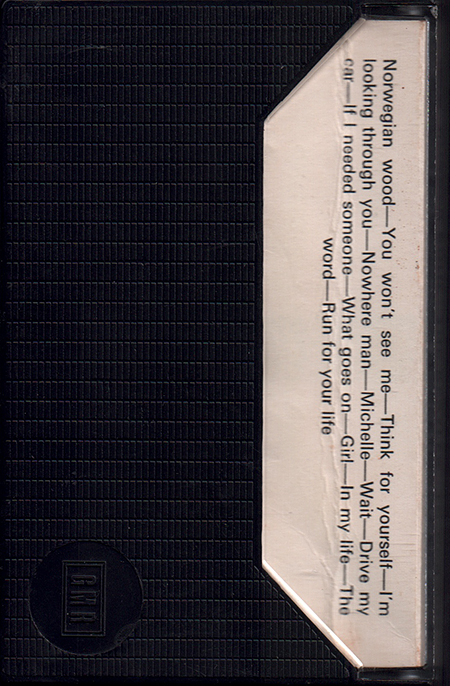 |
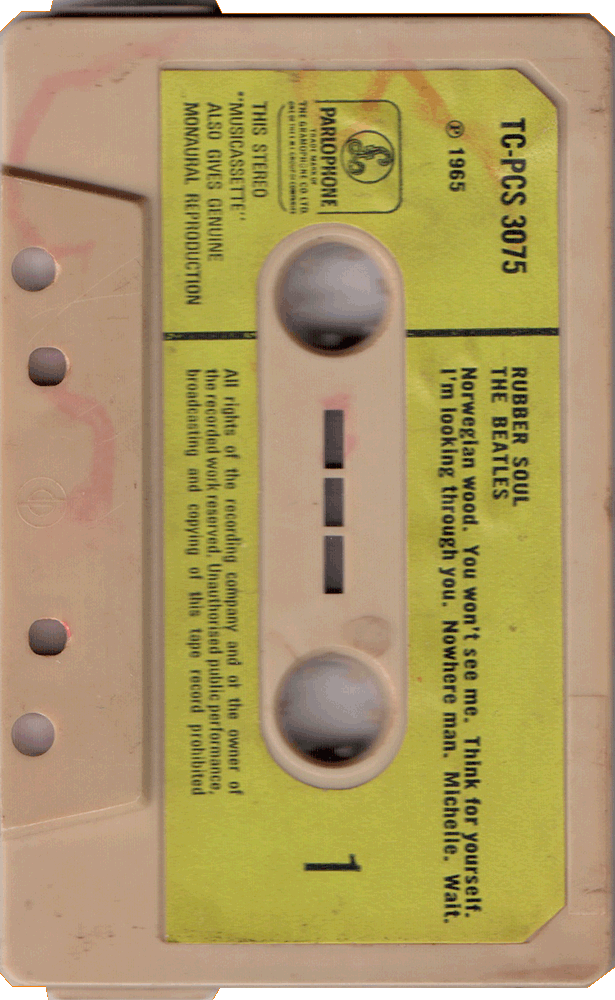 |
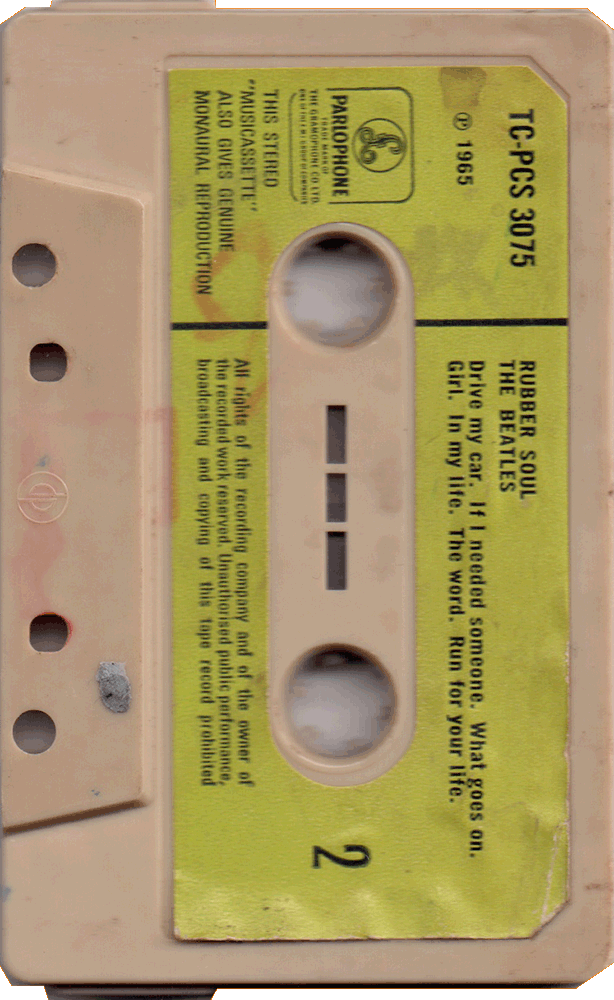 |
|
| The cassette cases ("Norelco" cases)
were clear plastic at the front and around the spine area,
and black plastic at the rear. |
The first UK issue of "Rubber Soul" has Lemon Yellow paper label
with Parlophone logo. Has the 3 windows shell. |
|||
| INLAY |
INLAY: FRONT | INLAY: INSIDE |
||
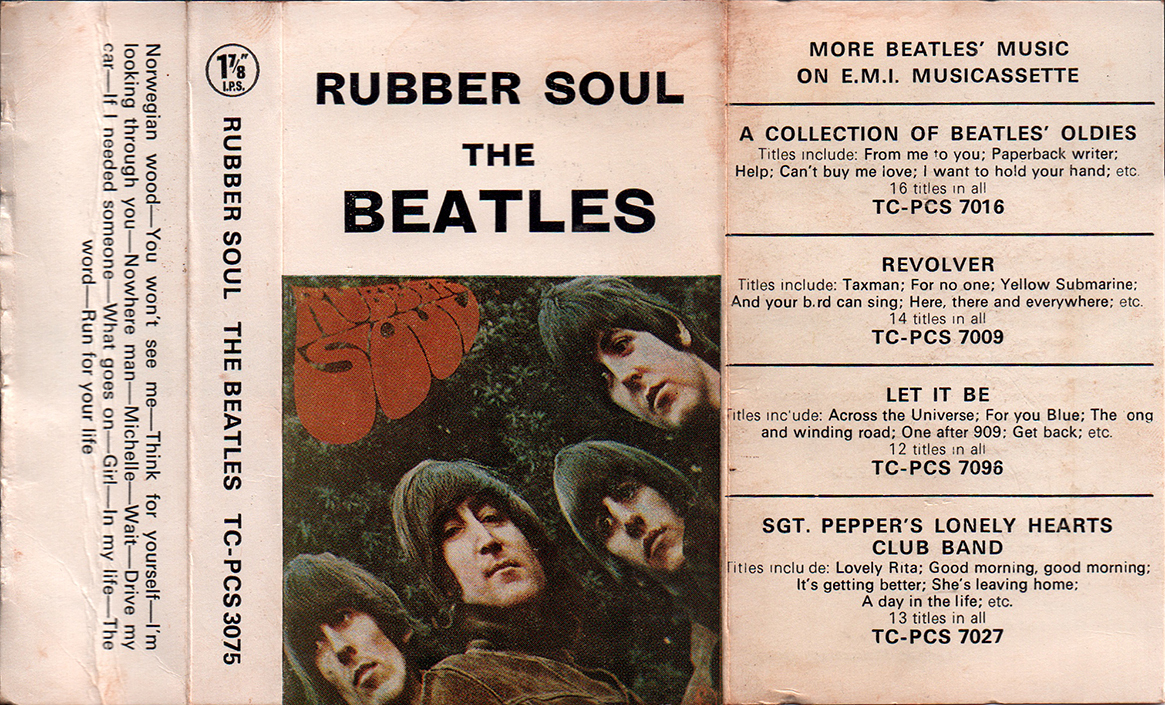 |
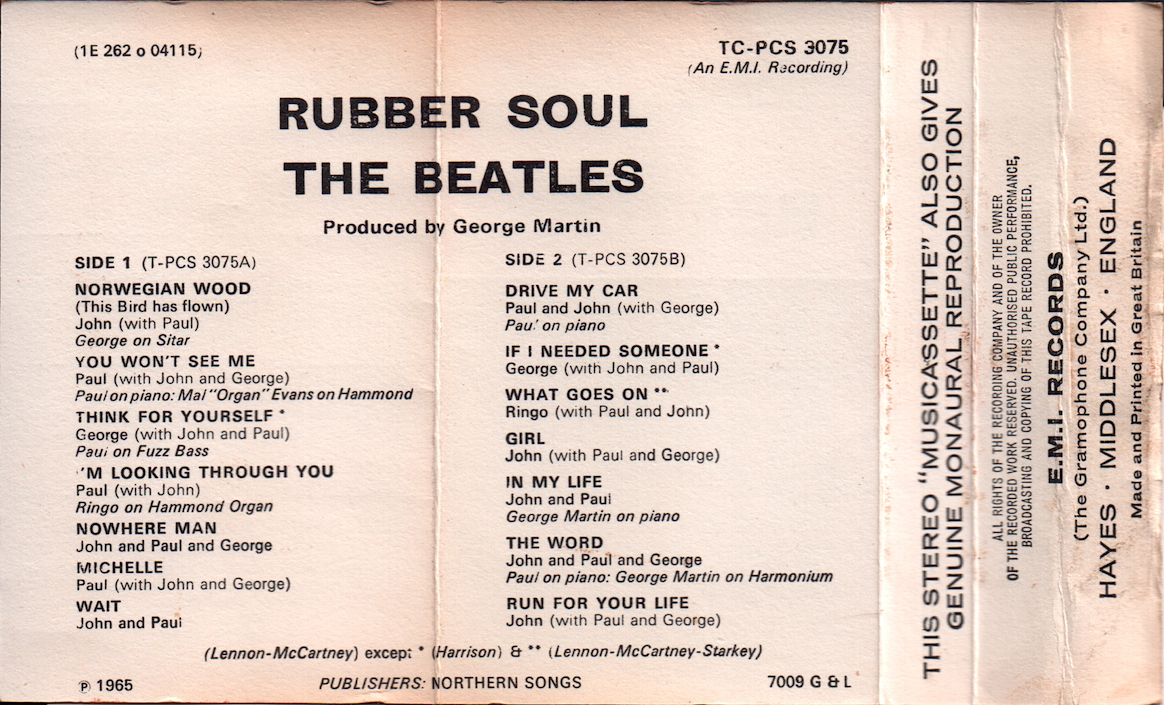 |
|||
| The 1970/71 cassettes had white inlays
and, aside from the small reproduction of the front cover,
no artwork was included nor the original liner notes. The
tracklistings were printed on the reverse of the inlay
whilst the foldovers advertised other available Beatles/solo
cassettes. |
||||
| INLAY: FRONT CLOSE UP | ||||
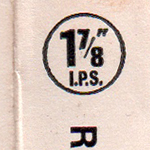 |
The
circular 1 7/8 " I.P.S. mark was printed at the spine. As the standard tape speed for a compact cassette is 1 ⅞ ips (1.875 inches per second). |
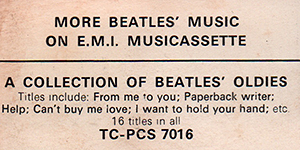 |
The tracklistings were
printed on the reverse of the inlay whilst the foldovers
advertised other available Beatles cassettes. |
|
| INLAY: FRONT CLOSE UP | ||||
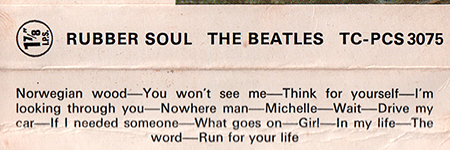 |
EMI
originally issued the Beatles UK albums on cassette tape
with re-arranged running orders, the reason for this was
that because of the 8-track stereo tapes made at the same
time, it was necessary to adjust the endless tape's four
tracks to be approximately the same length. |
|||
| INLAY: INSIDE CLOSE UP | INLAY: INSIDE CLOSE UP | |||
 |
Catalog number "TC-PCS 3075" and the EMI country code (*1) were printed on the inlay. | 
|
The
recording published credit "(P)-1965" statement was printed
at the left corner of the inlay. Press company's name and relrease date (maybe) "7009 G & L (Garrod & Lofthouse)" was printed at the bottom of the inlay. |
|
 |
 |
|||
| INLAY: INSIDE CLOSE UP | ||||
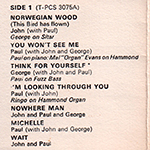 |
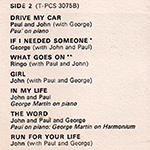 |
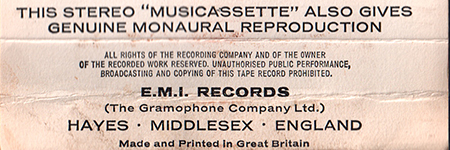 |
||
| The tracklistings were printed on the reverse of
the inlay. EMI originally issued the Beatles UK albums on
cassette tape with re-arranged running orders. |
"E.M.I. Records (The Gramophone Company Ltd.)" credit was printed at the bottom of the inside of the inlay. | |||
| LABEL CLOSE UP | ||||
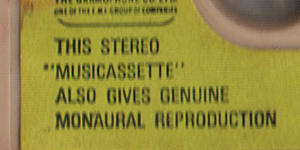 |
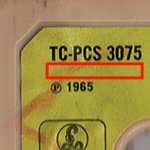 |
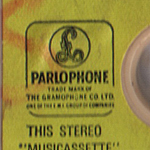 |
The 1st. cassettes were
issued with a £ Parlophone logo. NO "IE" catalogue
number in addition to the ordinary "TC-PCS 3075" EMI
catalogue number. |
|
| LABEL CLOSE UP | ||||
| SIDE
1 |
SIDE 2 |
The
tracklistings were printed on the reverse of the inlay. EMI
originally issued the Beatles UK albums on cassette tape
with re-arranged running orders. Has the 3 windows shell. |
||
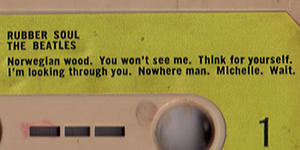 |
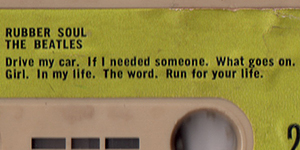 |
|||
| OTHER ITEM | ||||
| - |
||||
| LABEL | Lemon Yellow Paper Label with Parlophone
logo |
|||
| MIX | STEREO | |||
| RECORD COMPANY'S NAME | EMI Records (The Gramophone Company Ltd.) / An E.M.I. Recording | |||
| CENTRAL REMARK "SOLD IN U.K." |
- | |||
| RECORDING PUBLISHED CREDIT | (P) 1965 | |||
| INLAY FORM | "white" inlay (Foldover) |
|||
| SHELL | Light Grey Shell with 3 windows
(Phillips made?) / embossed "dp" logo mark |
|||
| CASSETTE CASE |
"Norelco"
cases: clear plastic at the front and around the spine area,
and black plastic at the rear. |
|||
| PRINTER CREDIT | Made and Printed in Great Britain / 7009 G
& L |
|||
| COVER DESIGN/ PHOTO/ NOTES | Photo: Robert Freeman | |||
| PRODUCER | George Martin | |||
| COMMENTS | The original Beatles cassette
release of "Sgt. Peppers" in Oct. 1967, through "Abbey Road
(Nov. 1969)", "Let It Be (August 1970)", and the first
release of most of the other Beatles cassette albums in
Sept. and Oct, 1970, just months after EMI opened their new
tape duplicating facilities at Hayes in Middlesex in July,
1970.
EMI opened its new tape duplicating facilities at Hayes, Middlesex in July 1970. All came with bright yellow paper label cassettes, their IE international catalogue numbers, and the newly designed, black box, EMI/Parlophone logo - although some were issued without the logo due to a lack of expensive letterpress blocks. The front and reverse of the inlays came in the "white inlay" design, for which the Let It Be inlay design of June 1970 was the template. The 1970/71 cassettes had white inlays and, aside from the small reproduction of the front cover, no artwork was included nor the original liner notes. Note the 7010 (or 7009) notation on the inside inlay followed by either EJD, G&L or DP. This was the number of the month/year of issue, followed by the printers initials ( Ernest J Day, Garrod & Lofthouse or Data Packaging). Advertising for other Beatles/solo albums was on the foldover front, and the EMI UK catalogue no. (TC-PCS-XXXX) was on the front cover at the top and on the spine. The spine also carried the tape speed, 1&7/8 ths in a circular logo style at the top. The cassette cases ("Norelco" cases) were clear plastic at the front and around the spine area, and black plastic at the rear. EMI originally issued the Beatles UK albums on cassette tape with re-arranged running orders, the reason for this was that because of the 8-track stereo tapes made at the same time, it was necessary to adjust the endless tape's four tracks to be approximately the same length. Data Packaging Corporation (who also traded as Hellerman Data Packaging Ltd) supplied cassette and 8 track shells, tape and other components to the music industry. The "DP" logo can often be found moulded into cassette shells, especially during the early to mid 1970s. (*1) EMI country code: 1E 262 o 04115 The EMI country codes (introduced on 1 June, 1969): In most cases the EMI Codes are the first two letters of the record's catalog#. These EMI Country Codes were used to indicate the country in which the record was pressed. Note this doesn't necessarily means the record was also released in that country (from Discog). OC / 0C / 1E= UK |
|||
|
TITLE
|
RUBBER SOUL |
|||
| CATALOG NUMBER | TC-PCS 3075 / 1E 262 o 04115 |
|||
|
RELEASE DATE
|
middle 1971? / Second Issue? (Crossover issue) | |||
| TRACK LISTING | SIDE 1 | SIDE 2 | ||
| Norwegian Wood (This Bird Has
Flown) [A2] |
Drive My Car [A1] |
|||
| You Won't See Me [A3] | If I Needed Someone [B6] | |||
| Think For Yourself [A5] | What Goes On [B1] | |||
| I'm Looking Through You [B3] | Girl [B2] | |||
| Nowhere Man [A4] | In My Life [B4] | |||
| Michelle
[A7] |
The Word [A6] | |||
| Wait [B5] | Run For Your Life [B7] | |||
| CASSETTE CASE AND TAPE |
CASE FRONT | CASE BACK | SIDE 1 --> Click! | SIDE 2 --> Click! |
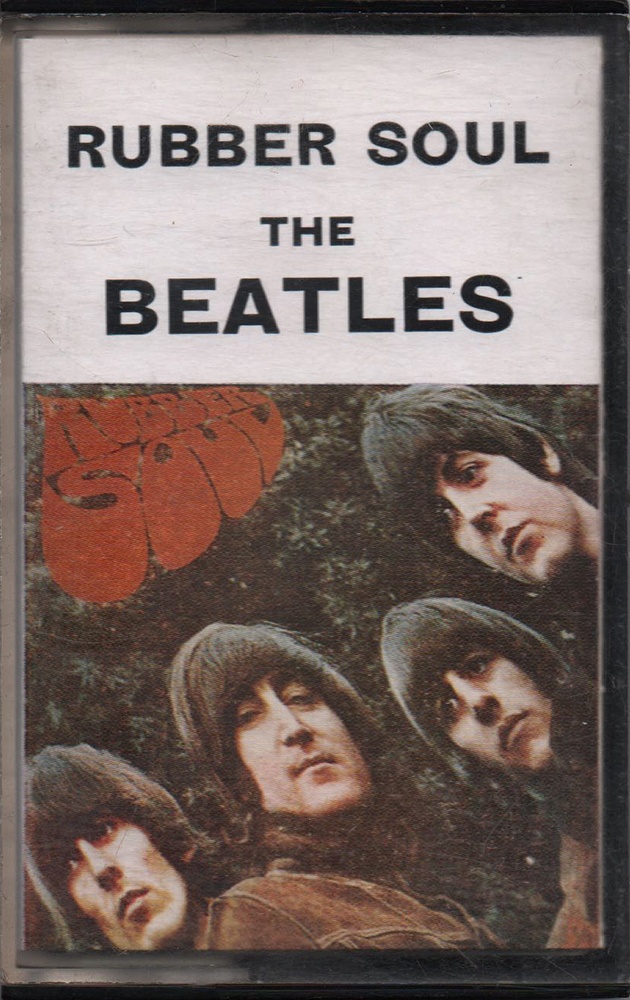 |
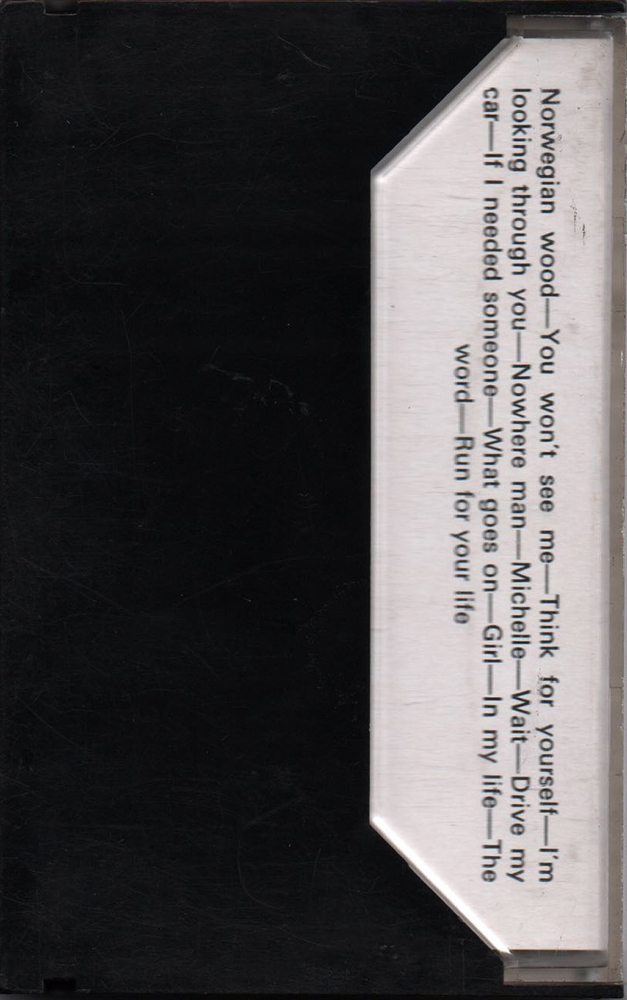 |
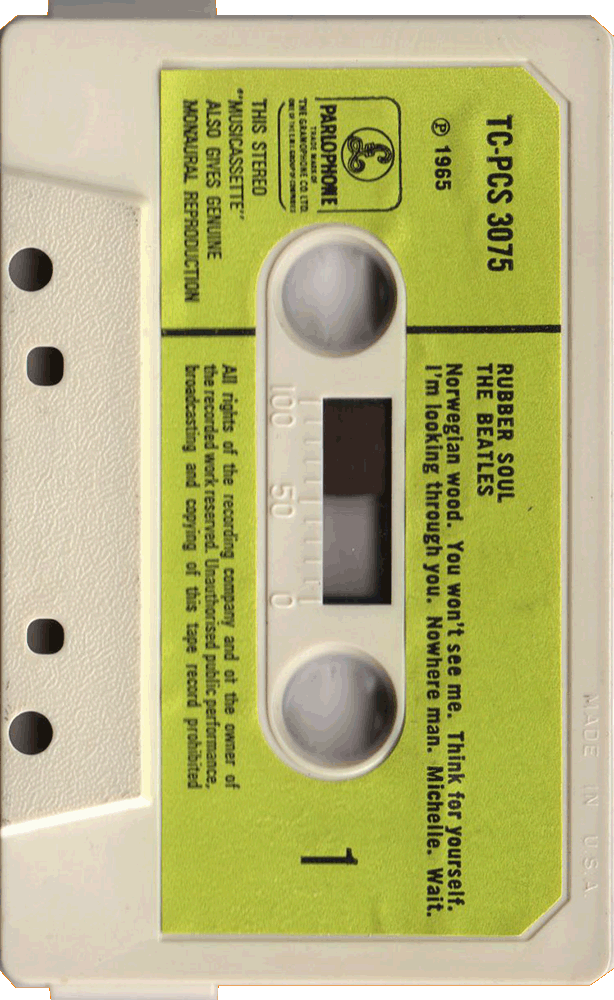 |
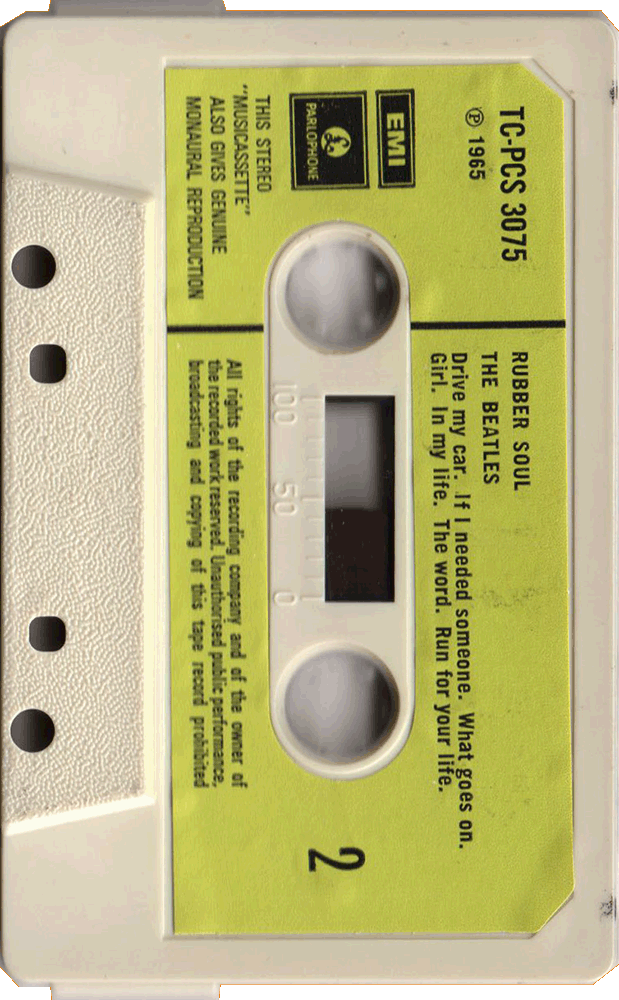 |
|
| The cassette cases ("Norelco" cases)
were clear plastic at the front and around the spine area,
and black plastic at the rear. |
This UK issue of "Rubber Soul" has Lemon Yellow
paper label: Side-1: Parlophone logo Side-2: EMI/Parlophone logo |
|||
| INLAY |
INLAY: FRONT | INLAY: INSIDE |
||
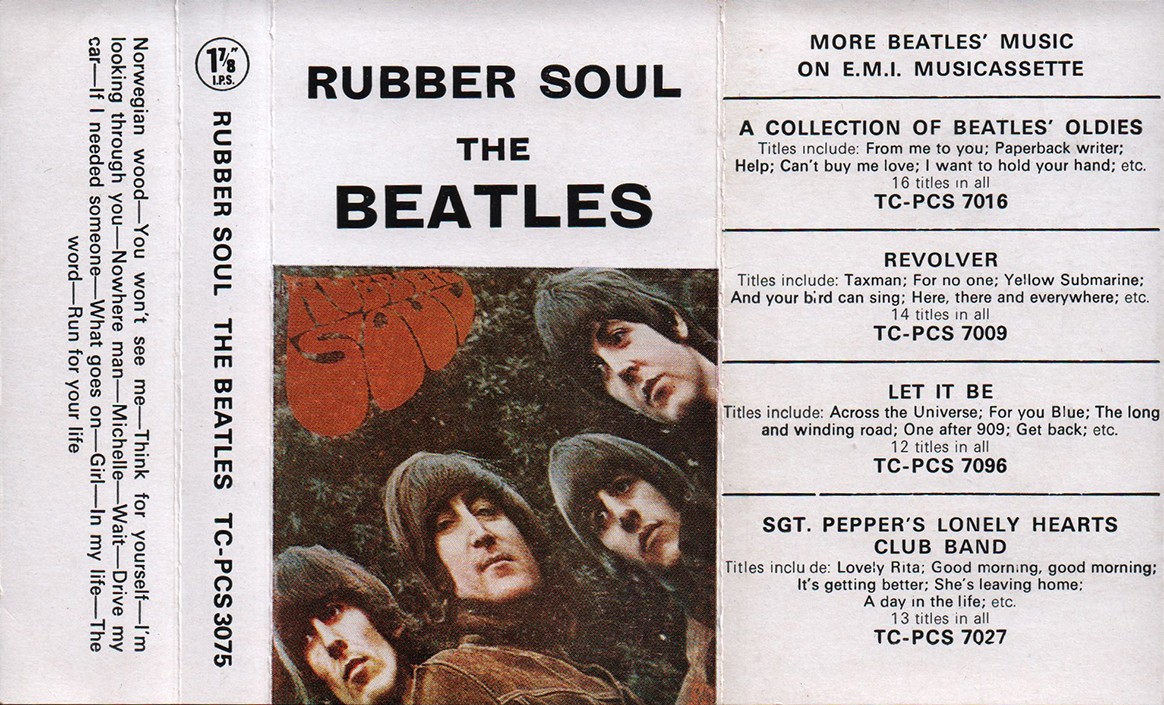 |
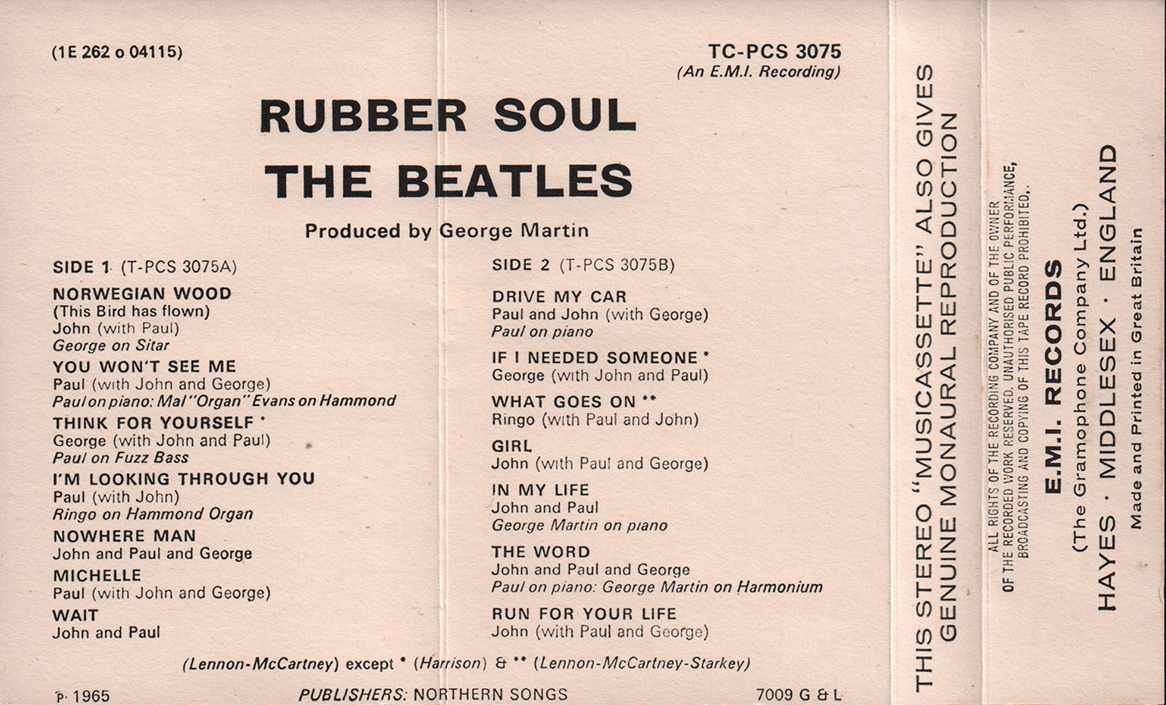 |
|||
| The 1970/71 cassettes had white inlays
and, aside from the small reproduction of the front cover,
no artwork was included nor the original liner notes. The
tracklistings were printed on the reverse of the inlay
whilst the foldovers advertised other available Beatles/solo
cassettes. |
||||
| INLAY: FRONT CLOSE UP | ||||
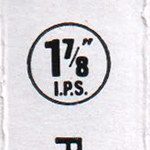 |
The
circular 1 7/8 " I.P.S. mark was printed at the spine. As the standard tape speed for a compact cassette is 1 ⅞ ips (1.875 inches per second). |
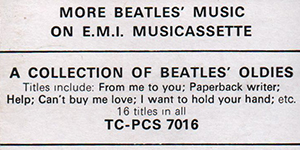 |
The tracklistings were
printed on the reverse of the inlay whilst the foldovers
advertised other available Beatles cassettes. |
|
| INLAY: FRONT CLOSE UP | ||||
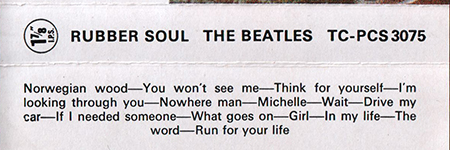 |
EMI
originally
issued
the Beatles UK albums on cassette tape with re-arranged
running orders, the reason for this was that because of the
8-track stereo tapes made at the same time, it was necessary
to adjust the endless tape's four tracks to be approximately
the same length. |
|||
| INLAY: INSIDE CLOSE UP | ||||
 |
 |
Catalog number "TC-PCS 3075" and the EMI country code (*1) were printed on the inlay. |  |
Printer's name and relrease date "7009 G & L (1970 Sep. Garrod & Lofthouse)" was printed of the inlay. |
 |
||||
| INLAY: INSIDE CLOSE UP | ||||
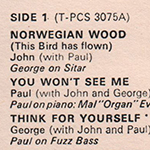 |
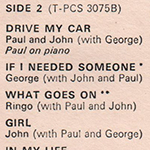 |
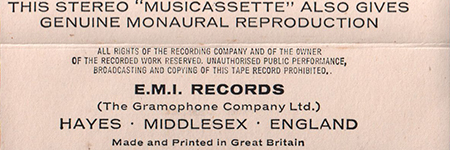 |
||
| The tracklistings were printed on the reverse of
the inlay. EMI originally issued the Beatles UK albums on
cassette tape with re-arranged running orders. |
"E.M.I. Records (The Gramophone Company Ltd.)" credit was printed at the bottom of the inside of the inlay. | |||
| LABEL CLOSE UP | ||||
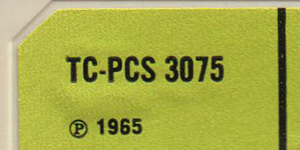 |
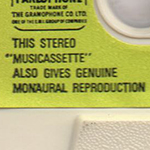 |
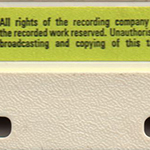 |
NO "IE" catalogue number in addition to the ordinary "TC-PCS 3075" EMI catalogue number. | |
| LABEL CLOSE UP | ||||
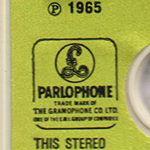 |
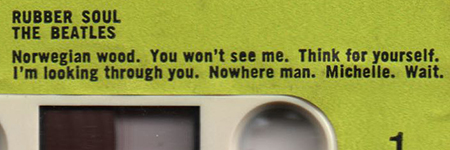 |
EMI originally
issued the Beatles UK albums on cassette tape with
re-arranged running orders, the reason for this was that
because of the 8-track stereo tapes made at the same time,
it was necessary to adjust the endless tape's four tracks to
be approximately the same length. |
||
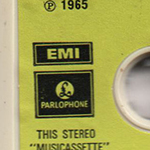 |
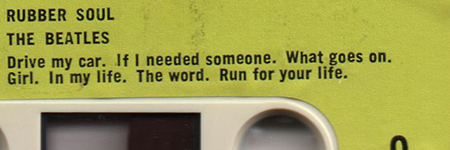 |
|||
| LABEL CLOSE UP | ||||
 |
"Made
in U.S.A" was embossed the shell. |
|||
| OTHER ITEM | ||||
| - |
||||
| LABEL | Lemon Yellow Paper Label with Parlophone & EMI/Parlophone
logo in black box |
|||
| MIX | STEREO | |||
| RECORD COMPANY'S NAME | EMI Records (The Gramophone Company Ltd.) / An E.M.I. Recording | |||
| CENTRAL REMARK "SOLD IN U.K." |
- | |||
| RECORDING PUBLISHED CREDIT | (P) 1965 | |||
| INLAY FORM | "white" inlay (Foldover) |
|||
| SHELL | White Shell / embossed "MADE IN
USA" |
|||
| CASSETTE CASE |
"Norelco"
cases:
clear
plastic at the front and around the spine area, and black
plastic at the rear. |
|||
| PRINTER CREDIT | Made and Printed in Great Britain / 7009 G
& L |
|||
| COVER DESIGN/ PHOTO/ NOTES | Photo: Robert Freeman | |||
| PRODUCER | George Martin | |||
| COMMENTS | The original Beatles cassette
release of "Sgt. Peppers" in Oct. 1967, through "Abbey Road
(Nov. 1969)", "Let It Be (August 1970)", and the first
release of most of the other Beatles cassette albums in
Sept. and Oct, 1970, just months after EMI opened their new
tape duplicating facilities at Hayes in Middlesex in July,
1970.
EMI opened its new tape duplicating facilities at Hayes, Middlesex in July 1970. All came with bright yellow paper label cassettes, their IE international catalogue numbers, and the newly designed, black box, EMI/Parlophone logo - although some were issued without the logo due to a lack of expensive letterpress blocks. The front and reverse of the inlays came in the "white inlay" design, for which the Let It Be inlay design of June 1970 was the template. The 1970/71 cassettes had white inlays and, aside from the small reproduction of the front cover, no artwork was included nor the original liner notes. Note the 7010 (or 7009) notation on the inside inlay followed by either EJD, G&L or DP (*2). This was the number of the month/year of issue, followed by the printers initials ( Ernest J Day, Garrod & Lofthouse or Data Packaging). Advertising for other Beatles/solo albums was on the foldover front, and the EMI UK catalogue no. (TC-PCS-XXXX) was on the front cover at the top and on the spine. The spine also carried the tape speed, 1&7/8 ths in a circular logo style at the top. The cassette cases ("Norelco" cases) were clear plastic at the front and around the spine area, and black plastic at the rear. Crossover Label: Side-1: Parlophone logo Side-2: EMI/Parlophone logo in black box "Made in U.S.A." was embossed the shell. EMI originally issued the Beatles UK albums on cassette tape with re-arranged running orders, the reason for this was that because of the 8-track stereo tapes made at the same time, it was necessary to adjust the endless tape's four tracks to be approximately the same length. (*1) EMI country code: 1E 262 o 04115 The EMI country codes (introduced on 1 June, 1969): In most cases the EMI Codes are the first two letters of the record's catalog#. These EMI Country Codes were used to indicate the country in which the record was pressed. Note this doesn't necessarily means the record was also released in that country (from Discog). OC / 0C / 1E= UK (*2) Data Packaging Corporation (who also traded as Hellerman Data Packaging Ltd) supplied cassette and 8 track shells, tape and other components to the music industry. The "DP" logo can often be found moulded into cassette shells, especially during the early to mid 1970s. |
|||
|
TITLE
|
RUBBER SOUL |
|||
| CATALOG NUMBER | TC-PCS 3075 / 1E 262 o 04115 |
|||
|
RELEASE DATE
|
middle 1971? / Second Issue | |||
| TRACK LISTING | SIDE 1 | SIDE 2 | ||
| Norwegian Wood (This Bird Has
Flown) [A2] |
Drive My Car [A1] |
|||
| You Won't See Me [A3] | If I Needed Someone [B6] | |||
| Think For Yourself [A5] | What Goes On [B1] | |||
| I'm Looking Through You [B3] | Girl [B2] | |||
| Nowhere Man [A4] | In My Life [B4] | |||
| Michelle
[A7] |
The Word [A6] | |||
| Wait [B5] | Run For Your Life [B7] | |||
| CASSETTE CASE AND TAPE |
CASE FRONT | CASE BACK | SIDE 1 --> Click! | SIDE 2 --> Click! |
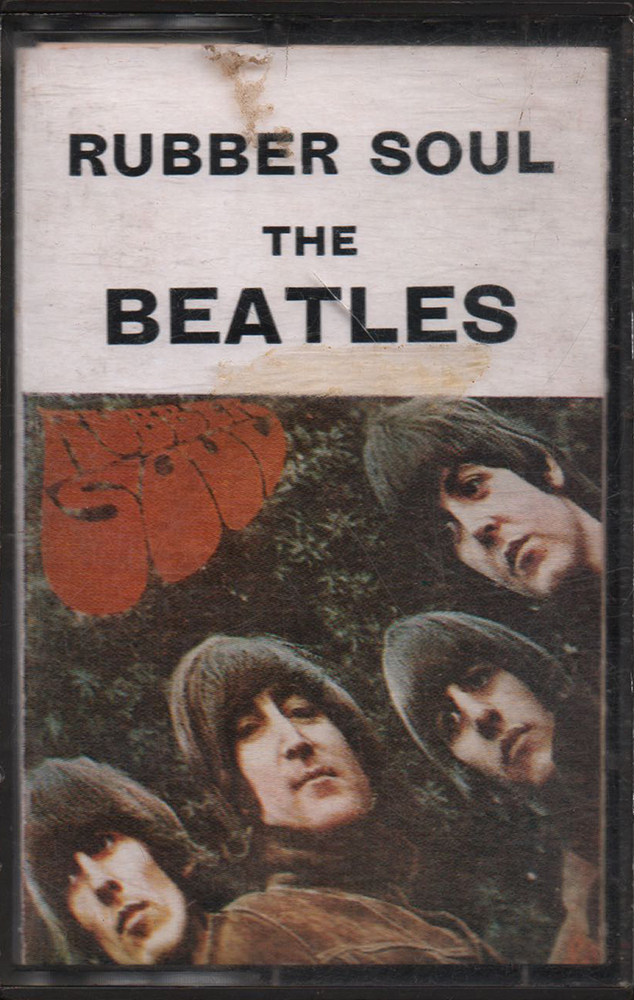 |
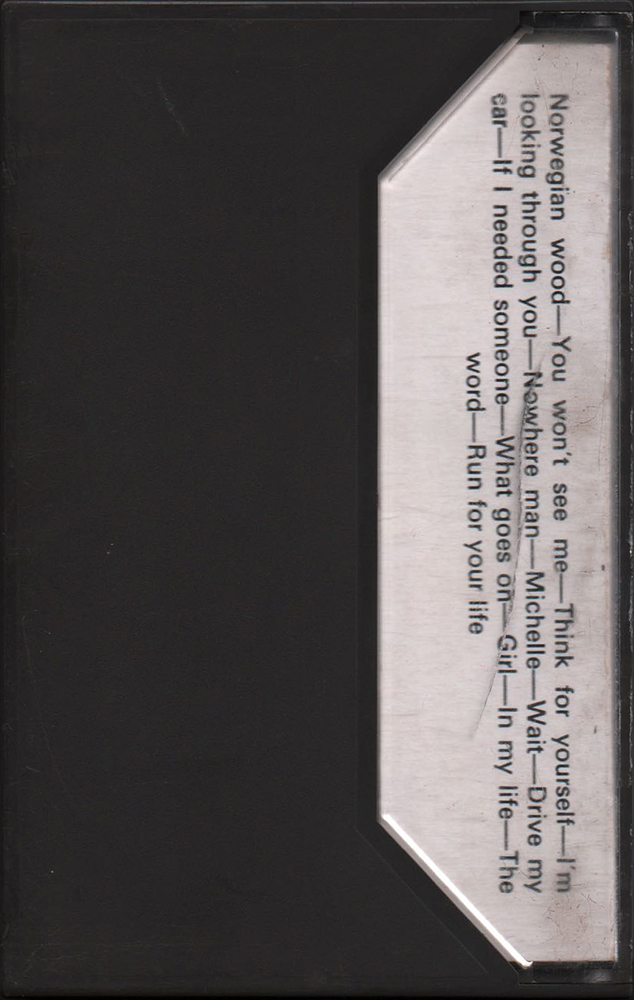 |
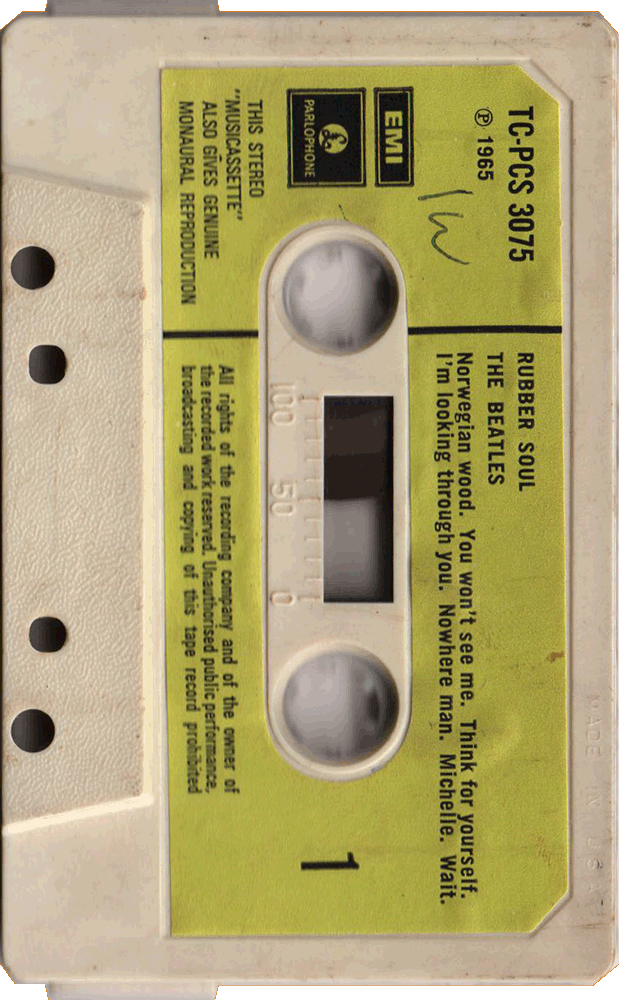 |
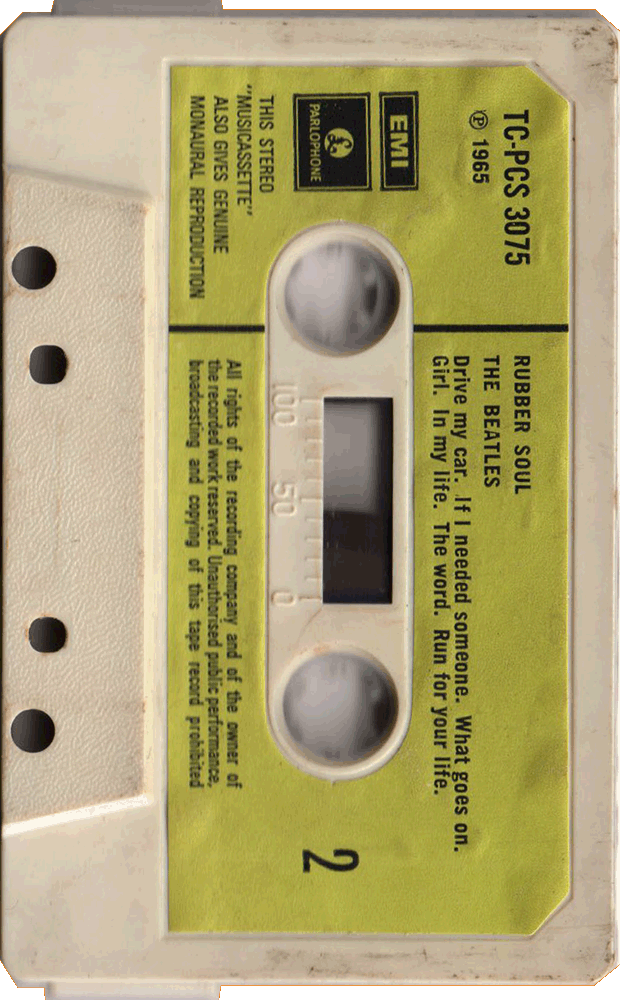 |
|
| The cassette cases ("Norelco" cases)
were clear plastic at the front and around the spine area,
and black plastic at the rear. |
This UK issue of "Rubber Soul" has Lemon Yellow
paper label with EMI/Parlophone logo on both sides |
|||
| INLAY |
INLAY: FRONT | INLAY: INSIDE |
||
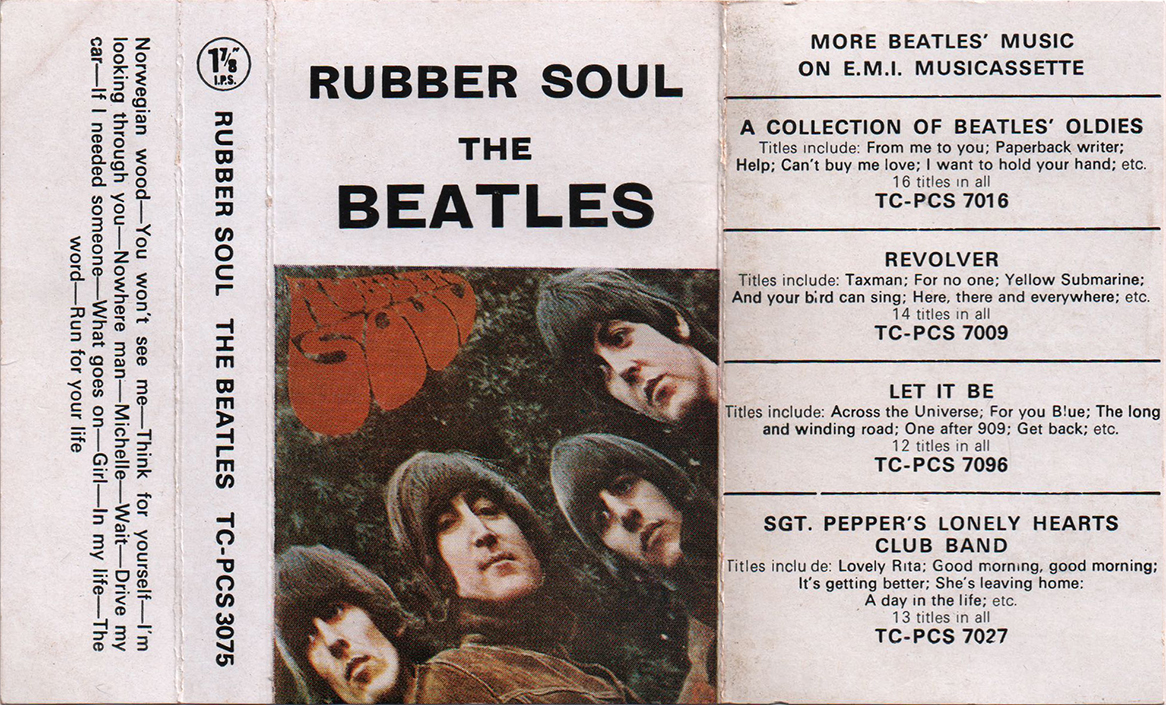 |
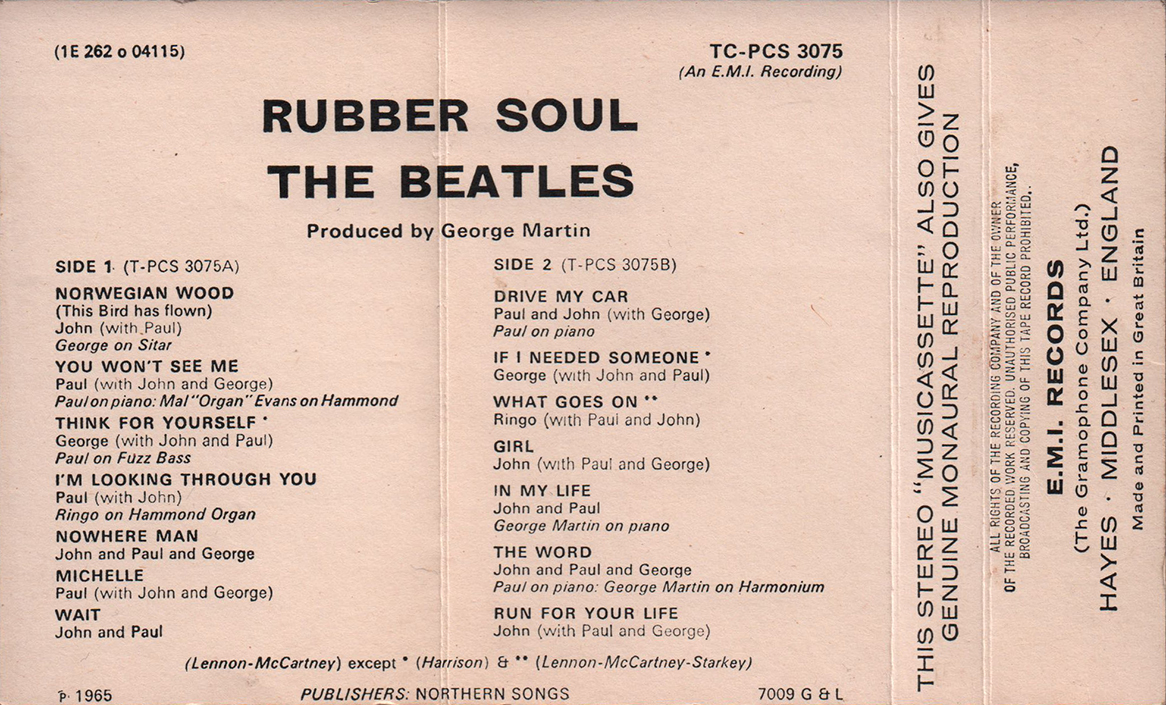 |
|||
| The 1970/71 cassettes had white inlays
and, aside from the small reproduction of the front cover,
no artwork was included nor the original liner notes. The
tracklistings were printed on the reverse of the inlay
whilst the foldovers advertised other available Beatles/solo
cassettes. |
||||
| INLAY: FRONT CLOSE UP | ||||
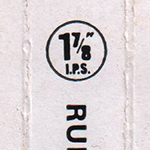 |
The
circular 1 7/8 " I.P.S. mark was printed at the spine. As the standard tape speed for a compact cassette is 1 ⅞ ips (1.875 inches per second). |
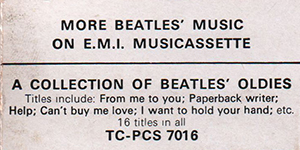 |
The tracklistings were
printed on the reverse of the inlay whilst the foldovers
advertised other available Beatles cassettes. |
|
| INLAY: FRONT CLOSE UP | ||||
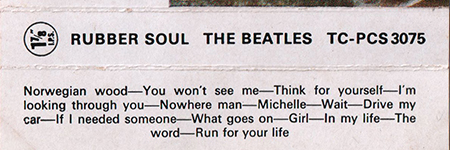 |
EMI
originally
issued
the
Beatles UK albums on cassette tape with re-arranged running
orders, the reason for this was that because of the 8-track
stereo tapes made at the same time, it was necessary to
adjust the endless tape's four tracks to be approximately
the same length. |
|||
| INLAY: INSIDE CLOSE UP | ||||
 |
 |
Catalog number "TC-PCS 3075" and the EMI country code (*1) were printed on the inlay. |  |
Printer's name and relrease date "7009 G & L (1970 Sep. Garrod & Lofthouse)" was printed of the inlay. |
 |
||||
| INLAY: INSIDE CLOSE UP | ||||
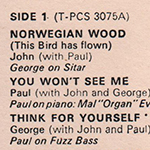 |
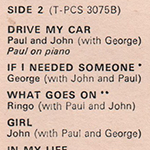 |
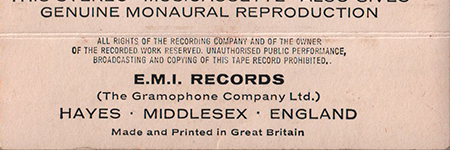 |
||
| The tracklistings were printed on the reverse of
the inlay. EMI originally issued the Beatles UK albums on
cassette tape with re-arranged running orders. |
"E.M.I. Records (The Gramophone Company Ltd.)" credit was printed at the bottom of the inside of the inlay. | |||
| LABEL CLOSE UP | ||||
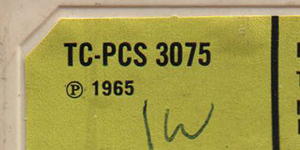 |
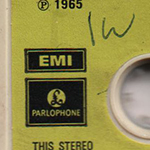 |
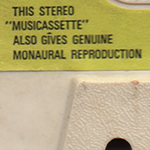 |
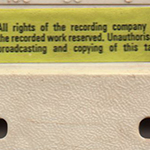 |
|
| NO "IE"
catalogue number in addition to the ordinary "TC-PCS 3075"
EMI catalogue number. The later 1970 onwards prints of the second issue had bright yellow paper labels and carried the new black box EMI/Parlophone logo (or NO logo at all.) |
Containing content as a
prerecorded cassette is called "Musicassette" |
The "DP(**)" logo was not
embossed on the cassette shells. |
||
| LABEL CLOSE UP | ||||
| The
tracklistings were printed on the reverse of the inlay. EMI
originally issued the Beatles UK albums on cassette tape
with re-arranged running orders. |
||||
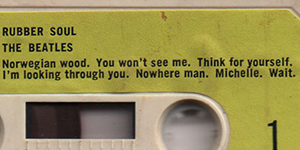 |
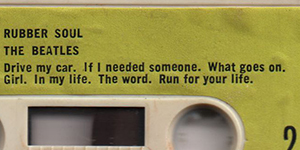 |
|||
| LABEL CLOSE UP | ||||
 |
"Made
in
U.S.A" was embossed the shell. |
|||
| OTHER ITEM | ||||
| - |
||||
| LABEL | Lemon Yellow Paper Label with EMI/Parlophone logo in black
box |
|||
| MIX | STEREO | |||
| RECORD COMPANY'S NAME | EMI Records (The Gramophone Company Ltd.) / An E.M.I. Recording | |||
| CENTRAL REMARK "SOLD IN U.K." |
- | |||
| RECORDING PUBLISHED CREDIT | (P) 1965 | |||
| INLAY FORM | "white" inlay (Foldover) |
|||
| SHELL | White Shell / embossed "MADE IN
USA" |
|||
| CASSETTE CASE |
"Norelco"
cases:
clear
plastic
at the front and around the spine area, and black plastic at
the rear. |
|||
| PRINTER CREDIT | Made and Printed in Great Britain / 7009 G
& L |
|||
| COVER DESIGN/ PHOTO/ NOTES | Photo: Robert Freeman | |||
| PRODUCER | George Martin | |||
| COMMENTS | The original Beatles cassette
release of "Sgt. Peppers" in Oct. 1967, through "Abbey Road
(Nov. 1969)", "Let It Be (August 1970)", and the first
release of most of the other Beatles cassette albums in
Sept. and Oct, 1970, just months after EMI opened their new
tape duplicating facilities at Hayes in Middlesex in July,
1970.
EMI opened its new tape duplicating facilities at Hayes, Middlesex in July 1970. All came with bright yellow paper label cassettes, their IE international catalogue numbers, and the newly designed, black box, EMI/Parlophone logo - although some were issued without the logo due to a lack of expensive letterpress blocks. The front and reverse of the inlays came in the "white inlay" design, for which the Let It Be inlay design of June 1970 was the template. The 1970/71 cassettes had white inlays and, aside from the small reproduction of the front cover, no artwork was included nor the original liner notes. Note the 7010 (or 7009) notation on the inside inlay followed by either EJD, G&L or DP (*2). This was the number of the month/year of issue, followed by the printers initials ( Ernest J Day, Garrod & Lofthouse or Data Packaging). Advertising for other Beatles/solo albums was on the foldover front, and the EMI UK catalogue no. (TC-PCS-XXXX) was on the front cover at the top and on the spine. The spine also carried the tape speed, 1&7/8 ths in a circular logo style at the top. The cassette cases ("Norelco" cases) were clear plastic at the front and around the spine area, and black plastic at the rear. "Made in U.S.A." was embossed the shell. EMI originally issued the Beatles UK albums on cassette tape with re-arranged running orders, the reason for this was that because of the 8-track stereo tapes made at the same time, it was necessary to adjust the endless tape's four tracks to be approximately the same length. (*1) EMI country code: 1E 262 o 04115 The EMI country codes (introduced on 1 June, 1969): In most cases the EMI Codes are the first two letters of the record's catalog#. These EMI Country Codes were used to indicate the country in which the record was pressed. Note this doesn't necessarily means the record was also released in that country (from Discog). OC / 0C / 1E= UK (*2) Data Packaging Corporation (who also traded as Hellerman Data Packaging Ltd) supplied cassette and 8 track shells, tape and other components to the music industry. The "DP" logo can often be found moulded into cassette shells, especially during the early to mid 1970s. |
|||
|
TITLE
|
RUBBER SOUL |
|||
| CATALOG NUMBER | TC-PCS 3075 / 1E 262 o 04115 |
|||
|
RELEASE DATE
|
Late 1971? / Third Issue | |||
| TRACK LISTING | SIDE 1 | SIDE 2 | ||
| Norwegian Wood (This Bird Has
Flown) [A2] |
Drive My Car [A1] |
|||
| You Won't See Me [A3] | If I Needed Someone [B6] | |||
| Think For Yourself [A5] | What Goes On [B1] | |||
| I'm Looking Through You [B3] | Girl [B2] | |||
| Nowhere Man [A4] | In My Life [B4] | |||
| Michelle
[A7] |
The Word [A6] | |||
| Wait [B5] | Run For Your Life [B7] | |||
| CASSETTE CASE AND TAPE |
CASE FRONT | CASE BACK | SIDE 1 --> Click! | SIDE 2 --> Click! |
 |
 |
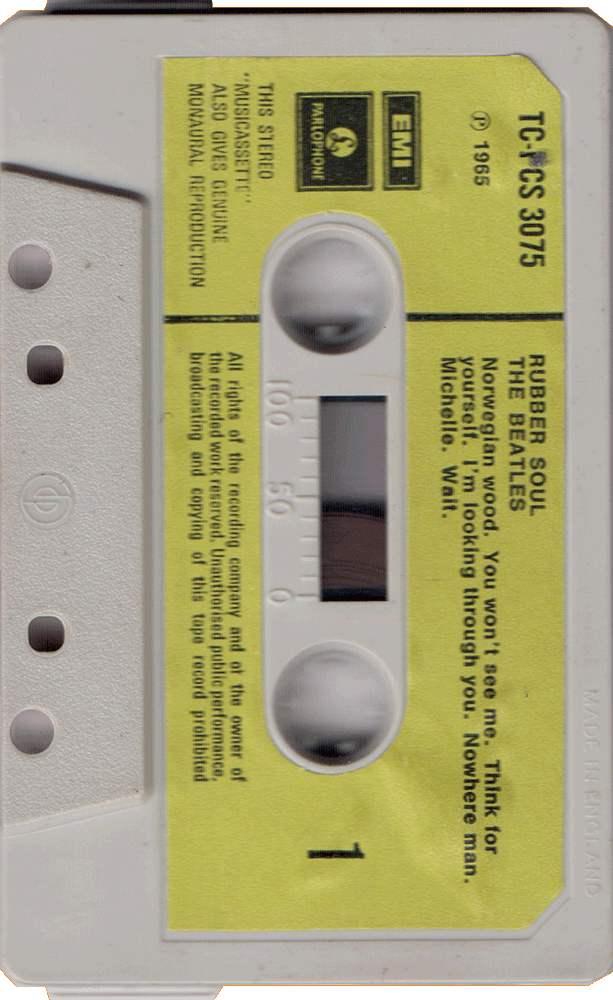 |
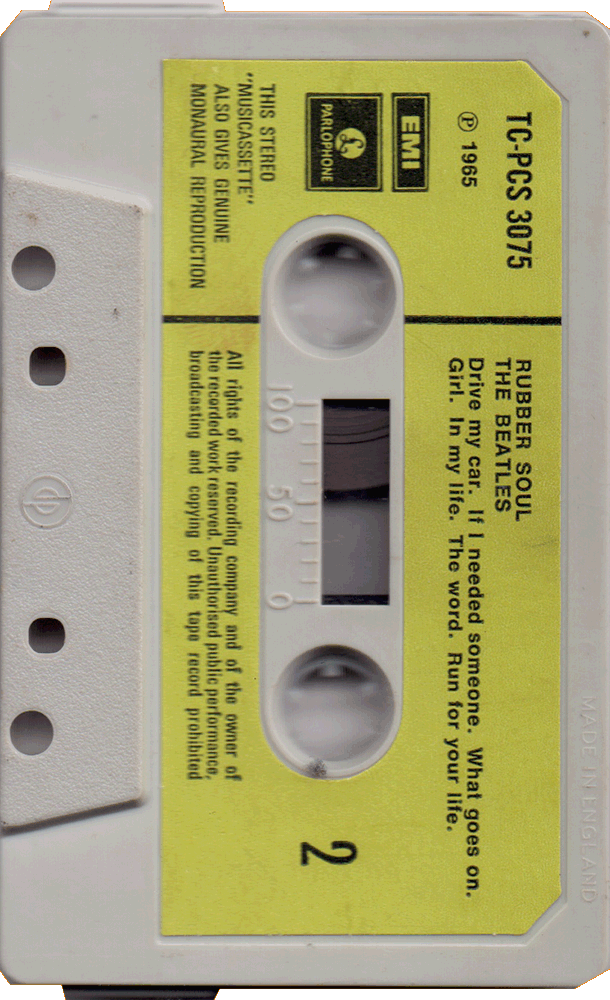 |
|
| The cassette cases ("Norelco" cases)
were clear plastic at the front and around the spine area,
and black plastic at the rear. |
This UK issue of "Rubber Soul" has Lemon Yellow paper label
with EMI/Parlophone logo |
|||
| INLAY |
INLAY: FRONT | INLAY: INSIDE |
||
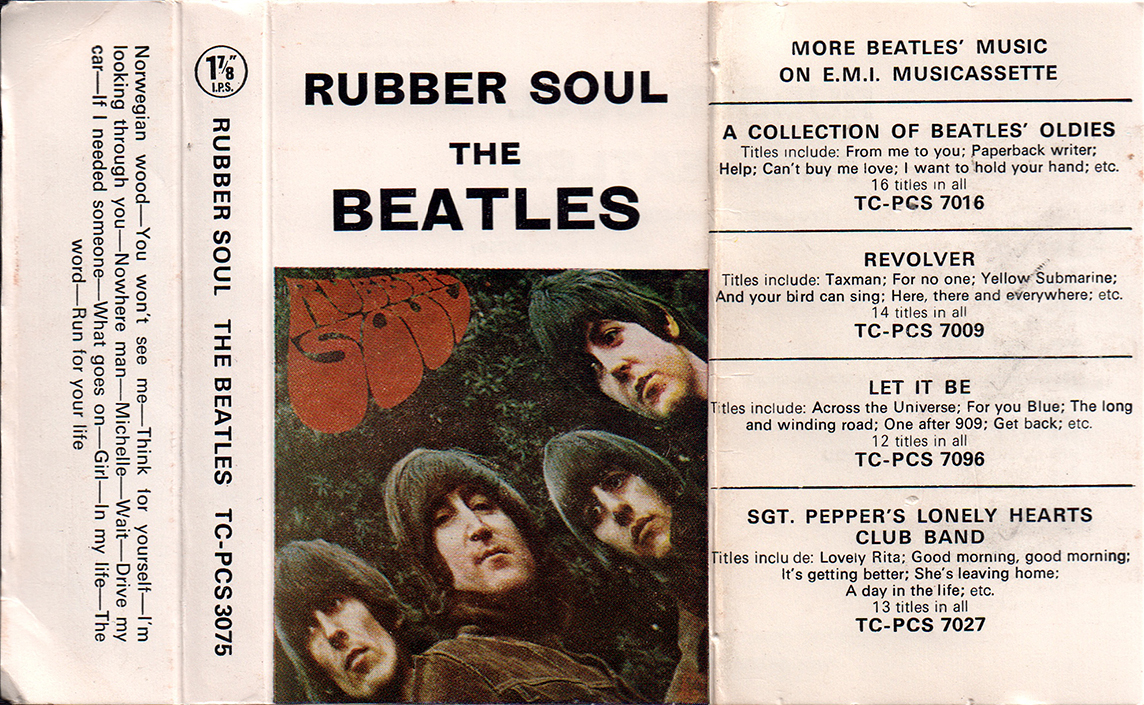 |
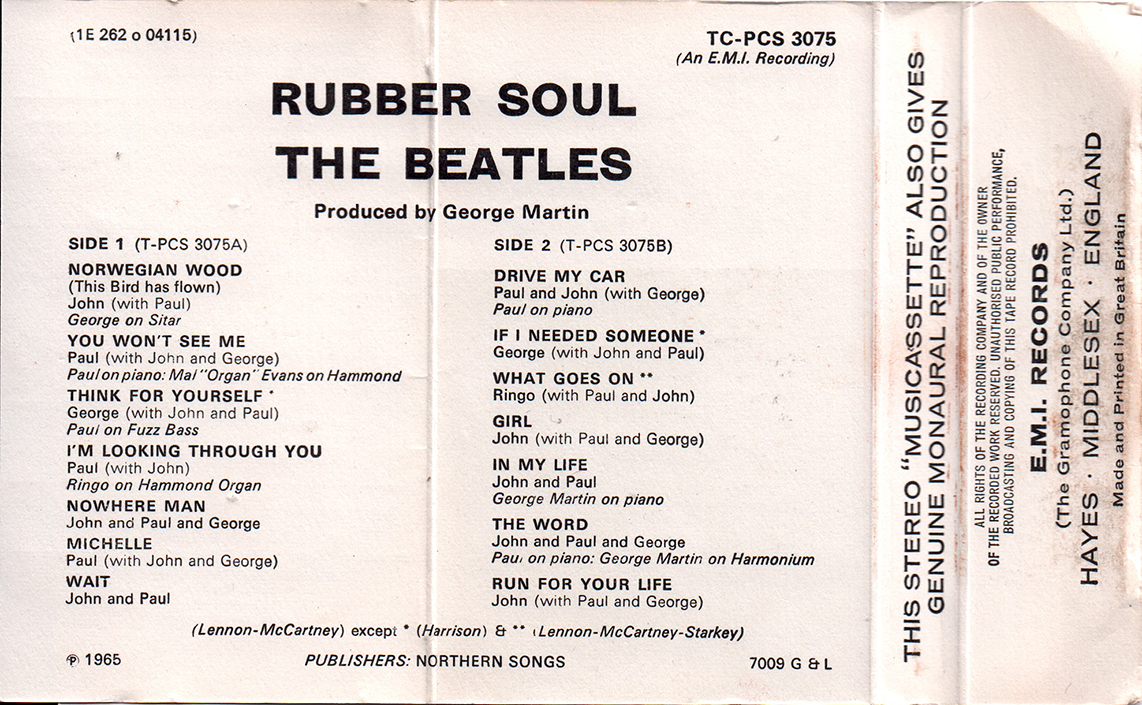 |
|||
| The 1970/71 cassettes had white inlays
and, aside from the small reproduction of the front cover,
no artwork was included nor the original liner notes. The
tracklistings were printed on the reverse of the inlay
whilst the foldovers advertised other available Beatles/solo
cassettes. |
||||
| INLAY: FRONT CLOSE UP | ||||
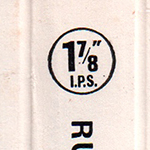 |
The
circular 1 7/8 " I.P.S. mark was printed at the spine. As the standard tape speed for a compact cassette is 1 ⅞ ips (1.875 inches per second). |
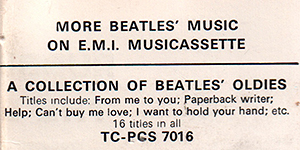 |
The tracklistings were
printed on the reverse of the inlay whilst the foldovers
advertised other available Beatles cassettes. |
|
| INLAY: FRONT CLOSE UP | ||||
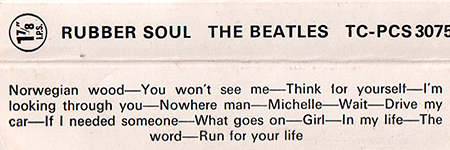 |
EMI
originally issued the Beatles UK albums on cassette tape
with re-arranged running orders, the reason for this was
that because of the 8-track stereo tapes made at the same
time, it was necessary to adjust the endless tape's four
tracks to be approximately the same length. |
|||
| INLAY: INSIDE CLOSE UP | INLAY: INSIDE CLOSE UP | |||
 |
Catalog number "TC-PCS 3075" and the EMI country code (*1) were printed on the inlay. | 
|
The
recording published credit "(P)-1965" statement was printed
at the left corner of the inlay. Press company's name and relrease date "7009 G & L (1970 Sep. Garrod & Lofthouse)" was printed at the bottom of the inlay. |
|
 |
 |
|||
| INLAY: INSIDE CLOSE UP | ||||
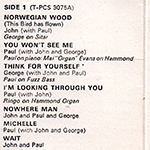 |
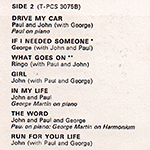 |
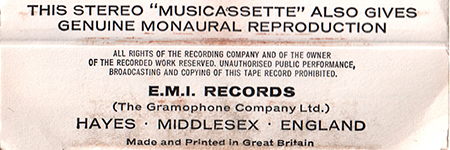 |
||
| The tracklistings were printed on the reverse of
the inlay. EMI originally issued the Beatles UK albums on
cassette tape with re-arranged running orders. |
"E.M.I. Records (The Gramophone Company Ltd.)" credit was printed at the bottom of the inside of the inlay. | |||
| LABEL CLOSE UP | ||||
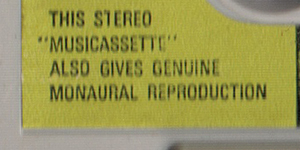 |
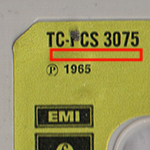 |
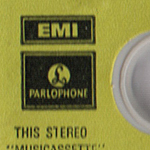 |
NO "IE" catalogue number
in addition to the ordinary "TC-PCS 3075" EMI catalogue
number. Had the new style black boxed EMI/Pharlophone logo introduced in September / October, 1970. |
|
| LABEL CLOSE UP | ||||
| SIDE
1 |
SIDE 2 |
The
tracklistings were printed on the reverse of the inlay. EMI
originally issued the Beatles UK albums on cassette tape
with re-arranged running orders. |
||
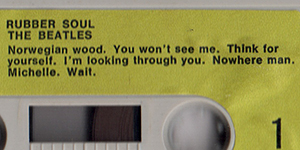 |
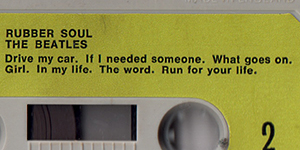 |
|||
| LABEL CLOSE UP | ||||
 |
"Made
in England" was embossed the shell. |
|||
| OTHER ITEM | ||||
| - |
||||
| LABEL | Lemon Yellow Paper Label with EMI/Parlophone logo in black
box |
|||
| MIX | STEREO | |||
| RECORD COMPANY'S NAME | EMI Records (The Gramophone Company Ltd.) / An E.M.I. Recording | |||
| CENTRAL REMARK "SOLD IN U.K." |
- | |||
| RECORDING PUBLISHED CREDIT | (P) 1965 | |||
| INLAY FORM | "white" inlay (Foldover) |
|||
| SHELL | Light Grey Shell / embossed "MADE
IN ENGLAND" and "dp" logo mark |
|||
| CASSETTE CASE |
"Norelco"
cases: clear plastic at the front and around the spine area,
and black plastic at the rear. |
|||
| PRINTER CREDIT | Made and Printed in Great Britain / 7009 G
& L |
|||
| COVER DESIGN/ PHOTO/ NOTES | Photo: Robert Freeman | |||
| PRODUCER | George Martin | |||
| COMMENTS | The original Beatles cassette
release of "Sgt. Peppers" in Oct. 1967, through "Abbey Road
(Nov. 1969)", "Let It Be (August 1970)", and the first
release of most of the other Beatles cassette albums in
Sept. and Oct, 1970, just months after EMI opened their new
tape duplicating facilities at Hayes in Middlesex in July,
1970.
EMI opened its new tape duplicating facilities at Hayes, Middlesex in July 1970. All came with bright yellow paper label cassettes, their IE international catalogue numbers, and the newly designed, black box, EMI/Parlophone logo - although some were issued without the logo due to a lack of expensive letterpress blocks. The front and reverse of the inlays came in the "white inlay" design, for which the Let It Be inlay design of June 1970 was the template. The 1970/71 cassettes had white inlays and, aside from the small reproduction of the front cover, no artwork was included nor the original liner notes. Note the 7010 (or 7009) notation on the inside inlay followed by either EJD, G&L or DP. This was the number of the month/year of issue, followed by the printers initials ( Ernest J Day, Garrod & Lofthouse or Data Packaging). Advertising for other Beatles/solo albums was on the foldover front, and the EMI UK catalogue no. (TC-PCS-XXXX) was on the front cover at the top and on the spine. The spine also carried the tape speed, 1&7/8 ths in a circular logo style at the top. The cassette cases ("Norelco" cases) were clear plastic at the front and around the spine area, and black plastic at the rear. EMI originally issued the Beatles UK albums on cassette tape with re-arranged running orders, the reason for this was that because of the 8-track stereo tapes made at the same time, it was necessary to adjust the endless tape's four tracks to be approximately the same length. Data Packaging Corporation (who also traded as Hellerman Data Packaging Ltd) supplied cassette and 8 track shells, tape and other components to the music industry. The "DP" logo can often be found moulded into cassette shells, especially during the early to mid 1970s. (*1) EMI country code: 1E 262 o 04115 The EMI country codes (introduced on 1 June, 1969): In most cases the EMI Codes are the first two letters of the record's catalog#. These EMI Country Codes were used to indicate the country in which the record was pressed. Note this doesn't necessarily means the record was also released in that country (from Discog). OC / 0C / 1E= UK |
|||
|
TITLE
|
RUBBER SOUL |
|||
| CATALOG NUMBER | TC-PCS 3075 / 1E 262 o 04115 |
|||
|
RELEASE DATE
|
Late 1971? / 4th Issue? | |||
| TRACK LISTING | SIDE 1 | SIDE 2 | ||
| Norwegian Wood (This Bird Has
Flown) [A2] |
Drive My Car [A1] |
|||
| You Won't See Me [A3] | If I Needed Someone [B6] | |||
| Think For Yourself [A5] | What Goes On [B1] | |||
| I'm Looking Through You [B3] | Girl [B2] | |||
| Nowhere Man [A4] | In My Life [B4] | |||
| Michelle
[A7] |
The Word [A6] | |||
| Wait [B5] | Run For Your Life [B7] | |||
| CASSETTE CASE AND TAPE |
CASE FRONT | CASE BACK | SIDE 1 --> Click! | SIDE 2 --> Click! |
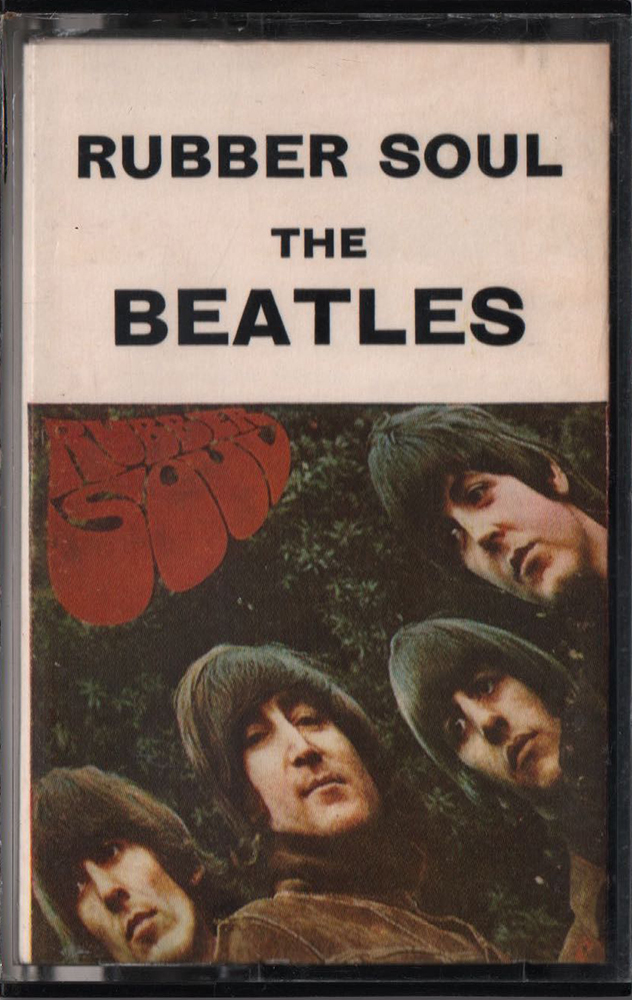 |
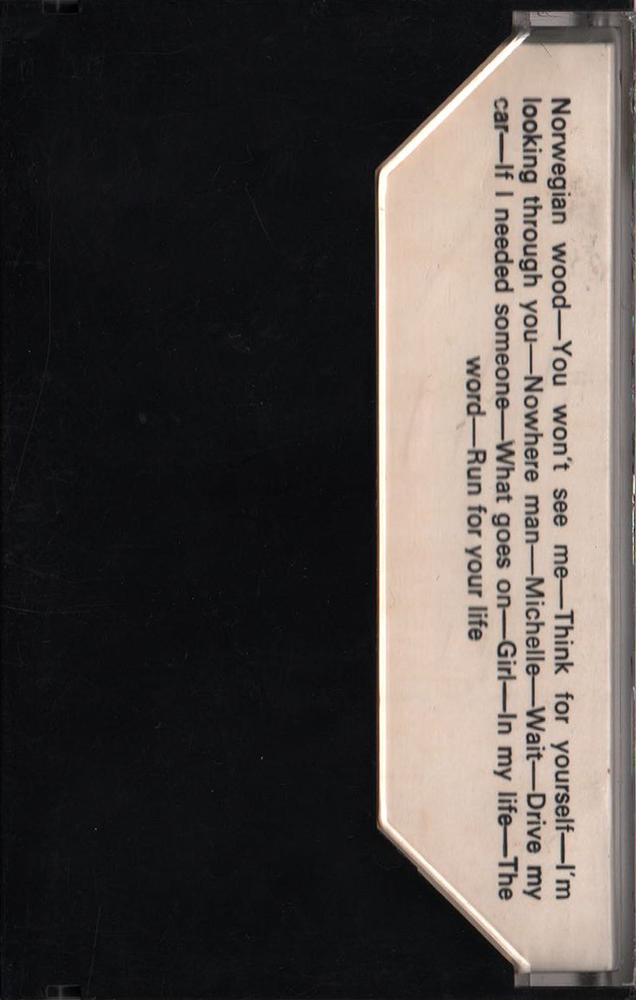 |
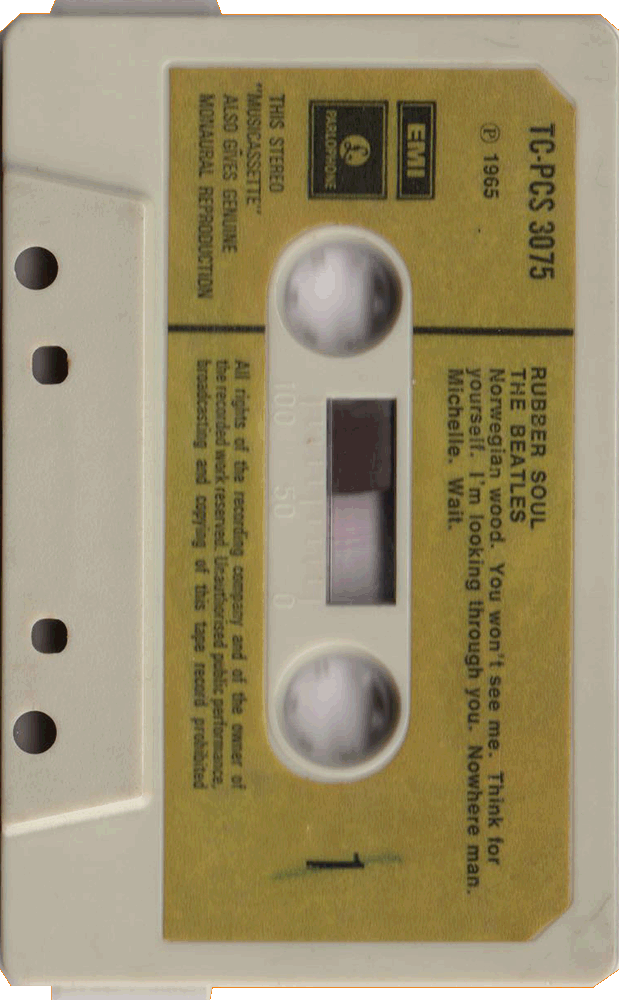 |
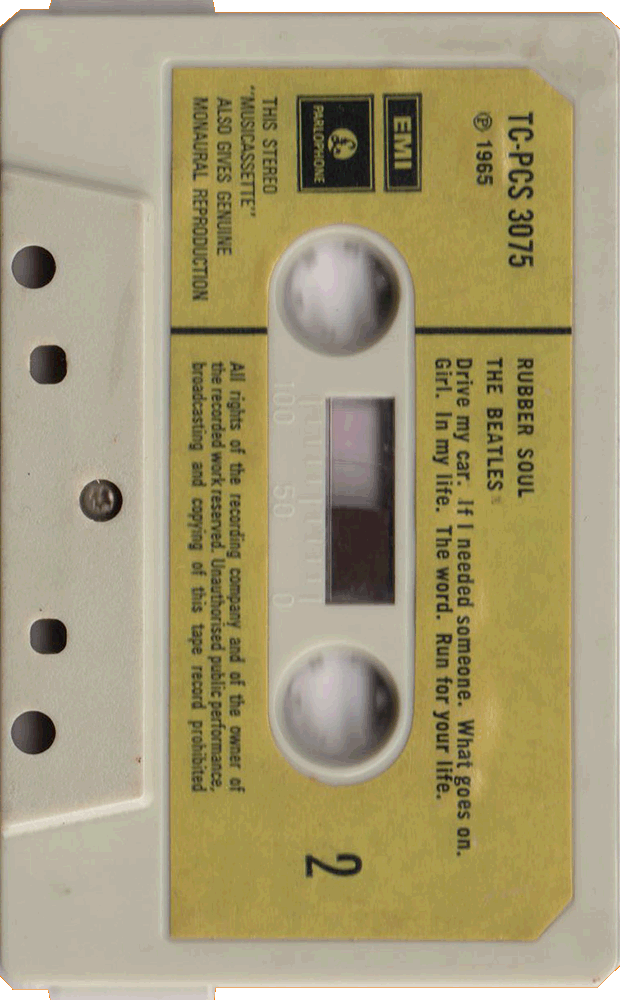 |
|
| The cassette cases ("Norelco" cases)
were clear plastic at the front and around the spine area,
and black plastic at the rear. |
This UK issue of "Rubber Soul" has Lemon Yellow paper label
with EMI/Parlophone logo |
|||
| INLAY |
INLAY: FRONT | INLAY: INSIDE |
||
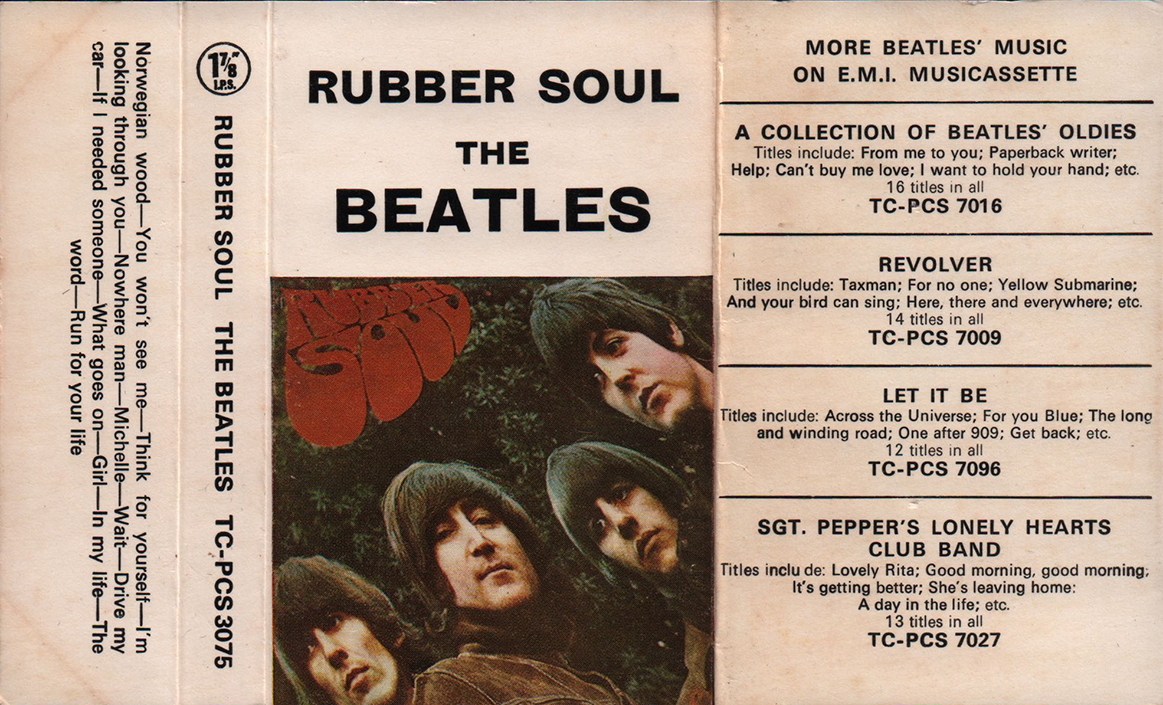 |
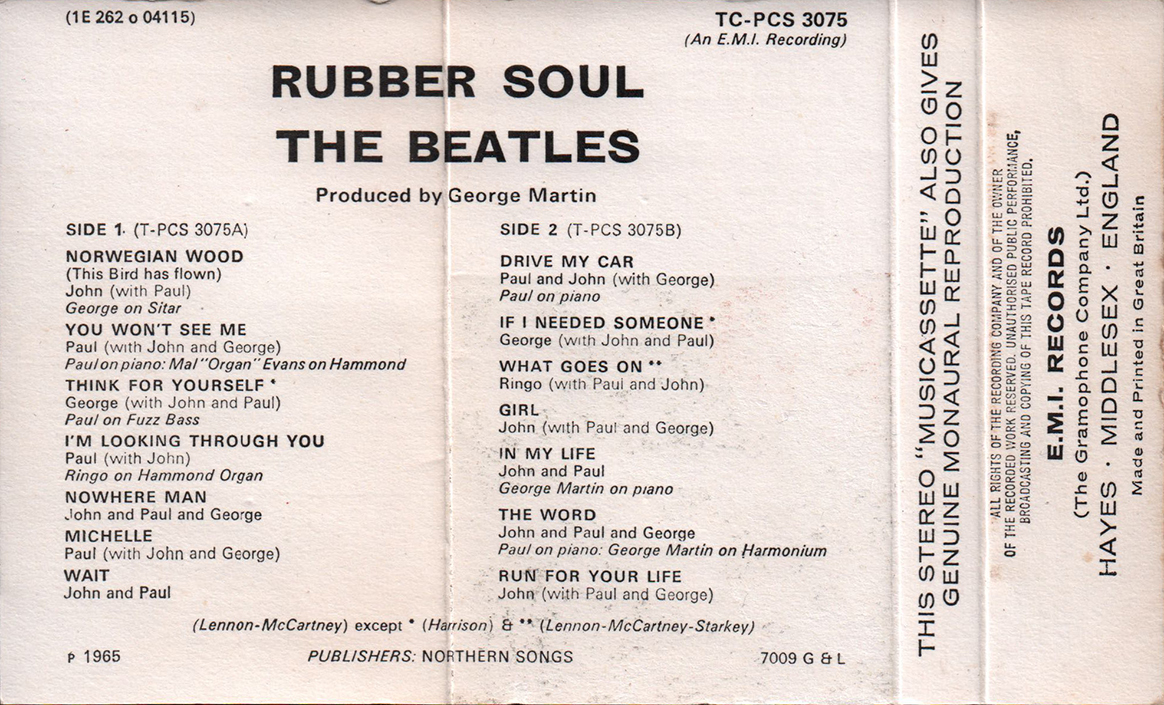 |
|||
| The 1970/71 cassettes had white inlays
and, aside from the small reproduction of the front cover,
no artwork was included nor the original liner notes. The
tracklistings were printed on the reverse of the inlay
whilst the foldovers advertised other available Beatles/solo
cassettes. |
||||
| INLAY: FRONT CLOSE UP | ||||
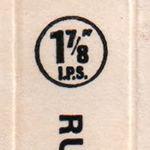 |
The
circular 1 7/8 " I.P.S. mark was printed at the spine. As the standard tape speed for a compact cassette is 1 ⅞ ips (1.875 inches per second). |
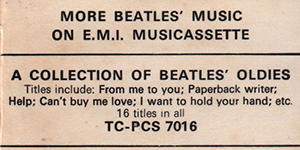 |
The tracklistings were
printed on the reverse of the inlay whilst the foldovers
advertised other available Beatles cassettes. |
|
| INLAY: FRONT CLOSE UP | ||||
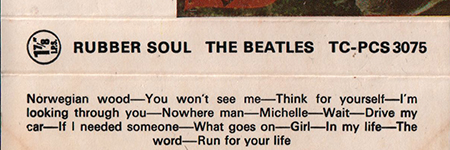 |
EMI
originally
issued the Beatles UK albums on cassette tape with
re-arranged running orders, the reason for this was that
because of the 8-track stereo tapes made at the same time,
it was necessary to adjust the endless tape's four tracks to
be approximately the same length. |
|||
| INLAY: INSIDE CLOSE UP | ||||
 |
 |
Catalog number "TC-PCS 3075" and the EMI country code (*1) were printed on the inlay. |  |
Printer's name and relrease date "7009 G & L (1970 Sep. Garrod & Lofthouse)" was printed of the inlay. |
 |
||||
| INLAY: INSIDE CLOSE UP | ||||
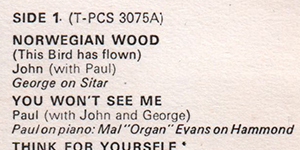 |
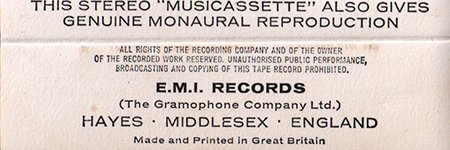 |
|||
| The tracklistings were printed on the reverse of
the inlay. EMI originally issued the Beatles UK albums on
cassette tape with re-arranged running orders. |
"E.M.I. Records (The Gramophone Company Ltd.)" credit was printed at the bottom of the inside of the inlay. | |||
| LABEL CLOSE UP | ||||
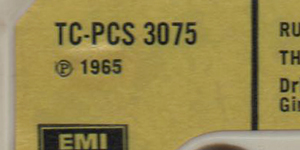 |
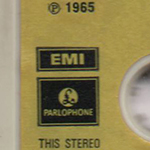 |
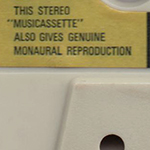 |
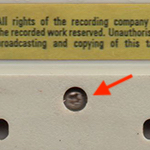 |
|
| NO "IE"
catalogue number in addition to the ordinary "TC-PCS 3075"
EMI catalogue number. The later 1970 onwards prints of the second issue had bright yellow paper labels and carried the new black box EMI/Parlophone logo (or NO logo at all.) |
Containing content as a prerecorded cassette is called "Musicassette" | It has a plain grey
unstamped tape shell with single screw fixing. |
||
| LABEL CLOSE UP | ||||
| SIDE
1 |
SIDE 2 |
The
tracklistings
were printed on the reverse of the inlay. EMI originally
issued the Beatles UK albums on cassette tape with
re-arranged running orders. |
||
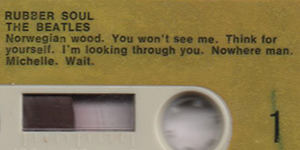 |
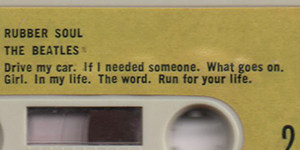 |
|||
| LABEL CLOSE UP | ||||
 |
"Made
in
England / Made in U.S.A" was not embossed the shell. |
|||
| OTHER ITEM | ||||
| - |
||||
| LABEL | Lemon Yellow Paper Label with EMI/Parlophone logo in black
box |
|||
| MIX | STEREO | |||
| RECORD COMPANY'S NAME | EMI Records (The Gramophone Company Ltd.) / An E.M.I. Recording | |||
| CENTRAL REMARK "SOLD IN U.K." |
- | |||
| RECORDING PUBLISHED CREDIT | (P) 1965 | |||
| INLAY FORM | "white" inlay (Foldover) |
|||
| SHELL | Light Grey Shell with single screw fixing. | |||
| CASSETTE CASE |
"Norelco"
cases:
clear plastic at the front and around the spine area, and
black plastic at the rear. |
|||
| PRINTER CREDIT | Made and Printed in Great Britain / 7009 G
& L |
|||
| COVER DESIGN/ PHOTO/ NOTES | Photo: Robert Freeman | |||
| PRODUCER | George Martin | |||
| COMMENTS | The original Beatles cassette
release of "Sgt. Peppers" in Oct. 1967, through "Abbey Road
(Nov. 1969)", "Let It Be (August 1970)", and the first
release of most of the other Beatles cassette albums in
Sept. and Oct, 1970, just months after EMI opened their new
tape duplicating facilities at Hayes in Middlesex in July,
1970.
EMI opened its new tape duplicating facilities at Hayes, Middlesex in July 1970. All came with bright yellow paper label cassettes, their IE international catalogue numbers, and the newly designed, black box, EMI/Parlophone logo - although some were issued without the logo due to a lack of expensive letterpress blocks. The front and reverse of the inlays came in the "white inlay" design, for which the Let It Be inlay design of June 1970 was the template. The 1970/71 cassettes had white inlays and, aside from the small reproduction of the front cover, no artwork was included nor the original liner notes. Note the 7010 (or 7009) notation on the inside inlay followed by either EJD, G&L or DP (*2). This was the number of the month/year of issue, followed by the printers initials ( Ernest J Day, Garrod & Lofthouse or Data Packaging). Advertising for other Beatles/solo albums was on the foldover front, and the EMI UK catalogue no. (TC-PCS-XXXX) was on the front cover at the top and on the spine. The spine also carried the tape speed, 1&7/8 ths in a circular logo style at the top. The cassette cases ("Norelco" cases) were clear plastic at the front and around the spine area, and black plastic at the rear. It has a plain grey unstamped tape shell with single screw fixing. "Made in England / Made in U.S.A." was not embossed the shell. EMI originally issued the Beatles UK albums on cassette tape with re-arranged running orders, the reason for this was that because of the 8-track stereo tapes made at the same time, it was necessary to adjust the endless tape's four tracks to be approximately the same length. (*1) EMI country code: 1E 262 o 04115 The EMI country codes (introduced on 1 June, 1969): In most cases the EMI Codes are the first two letters of the record's catalog#. These EMI Country Codes were used to indicate the country in which the record was pressed. Note this doesn't necessarily means the record was also released in that country (from Discog). OC / 0C / 1E= UK (*2) Data Packaging Corporation (who also traded as Hellerman Data Packaging Ltd) supplied cassette and 8 track shells, tape and other components to the music industry. The "DP" logo can often be found moulded into cassette shells, especially during the early to mid 1970s. |
|||
